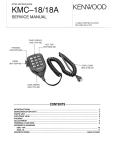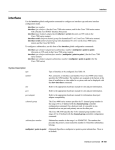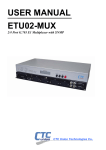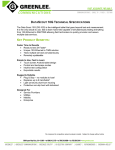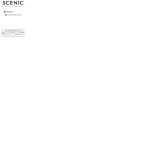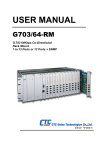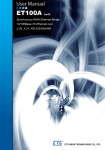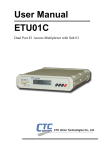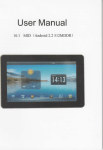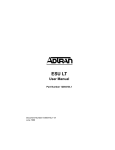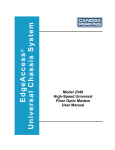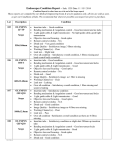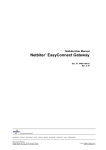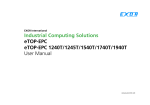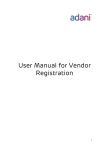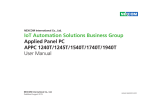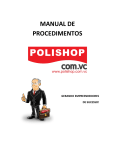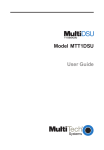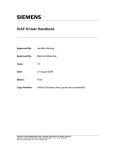Download TTU02-MUX User Manual
Transcript
USER MANUAL TTU02-MUX Fractional T1, 2 or 4 Port Multiplexer The information contained in this document is subject to change without prior notice. TRADEMARKS Microsoft is a registered trademark of Microsoft Corp. HyperTerminal™ is a registered trademark of Hilgraeve Inc. WARNING: This equipment has been tested and found to comply with the limits for a Class A digital device, pursuant to Part 15 of the FCC Rules. These limits are designed to provide reasonable protection against harmful interference when the equipment is operated in a commercial environment. This equipment generates, uses, and can radiate radio frequency energy and if not installed and used in accordance with the instruction manual may cause harmful interference in which case the user will be required to correct the interference at his own expense. NOTICE: (1) The changes or modifications not expressively approved by the party responsible for compliance could void the user's authority to operate the equipment. (2) Shielded interface cables and AC power cord, if any, must be used in order to comply with the emission limits. CISPR PUB.22 Class A COMPLIANCE: This device complies with EMC directive of the European Community and meets or exceeds the following technical standard. EN 55022 - Limits and Methods of Measurement of Radio Interference Characteristics of Information Technology Equipment. This device complies with CISPR Class A. WARNING: This is a Class A product. In a domestic environment this product may cause radio interference in which case the user may be required to take adequate measures. CE NOTICE Marking by the symbol CE indicates compliance of this equipment to the EMC directive of the European Community. Such marking is indicative that this equipment meets or exceeds the following technical standards: EN 55022:1994/A1:1995/A2:1997 Class A and EN61000-3-2:1995, EN61000-3-3:1995 and EN50082-1:1997 CTC Union Technologies Co., Ltd. Far Eastern Vienna Technologies Center (Neihu Technology Park) 9F, No. 60, Zhouzi Street, Neihu, Taipei, Taiwan Phone:(886) 2.2659.1021 Fax:(886) 2.2799.1355 E-mail: [email protected] http://www.ctcu.com TTU02-MUX 4 Port MUX, Fractional T1(DS1), Installation and Operation Manual Version 1.0 Sep 2000 Printing Version 1.0b Mar 2003 Printing Version 1.0c June 2004 Printing updating the latest I/F modules This manual supports the following models: TTU02-MUX.2-XX-AC, 2 Port MUX, universal AC TTU02-MUX.4-XX-AC, 4 Port MUX, universal AC TTU02-MUX.2-XX-DC, 2 Port MUX, DC model TTU02-MUX.4-XX-DC, 4 Port MUX, DC model Important Update Notice Commencing with production of the TTU02-MUX in March 2000, the Sub T1 Link has become an option. To incorporate this feature, firmware changes were made that moved the MAIN T1 link from the interface card to the mother PCB and SUB T1 link from the mother PCB to the interface card. Changes were also made to the unit back panel graphics to reflect the new positions. Note that on all new production, the Main T1 is below the Sub T1. The unit may now be ordered without the Sub T1 feature if it is not required. While referring to the manual for the TTU02-MUX, please note these differences in graphics and table settings for any older models. June 2004 notice: As of this printing, the sub-T1 is now a standard feature on all models. TABLE OF CONTENTS CHAPTER 1. INTRODUCTION ………………….……………………… 1 1.1 INTRODUCTION ……………………………………………………………… 1 1.2 FUNCTION DESCRIPTION …………………………………………………… 1 1.3 TYPICAL SYSTEM APPLICATIONS …………..…………………………….. 3 1.4 T1(DS1) SIGNAL STRUCTURE ……………………………………………….. 4 1.5 TTU02-MUX CAPABILITIES ………………………………………………… 5 1.6 TECHNICAL SPECIFICATIONS ……………………………………………… 8 CHAPTER 2. INSTALLATION ………………..………………………… 13 2.1 GENERAL ………………………………………………………………………. 13 2.2 SITE PREPARATION ……………………………….…………………………. 13 2.3 MECHANICAL ASSEMBLY ……………………..……………………………. 13 2.4 ELECTRICAL INSTALLATION ……………………………………………… 13 2.5 DATA INTERFACE MODULE REPLACEMENT .…………………………… 15 CHAPTER 3. FRONT PANEL OPERATION …………………………… 17 3.1 GENERAL ……………………………………………………………………… 17 3.2 CONTROLS AND INDICATORS ……………………………………………... 17 3.3 LCD MENU OPERATION ……………………………………………………… 18 CHAPTER 4. CONTROL PORT OPERATION ……………………....… 29 4.1 GENERAL ………………………………………………………………………. 29 4.2 TERMINAL CONNECTION …………………………………………………… 29 4.3 MENU SYSTEM DETAIL ……………………………………………………… 30 i TABLE OF CONTENTS CHAPTER 5. TEST AND DIAGNOSTICS ……………………………… 5.1 GENERAL ………………………………………………………………………. 61 61 5.2 STATUS INDICATORS AND MESSAGES ……………………………………. 61 5.3 USER ACTIVATED LOOPBACK ……………………………………………… 64 CHAPTER 6. TROUBLESHOOTING INSTRUCTIONS ….…………… 71 APPENDIX A. DIP SWITCH SETTING ………………………………….. 73 A.1 DSW1 SETTING ……………………………………………………………….... 73 A.2 JUMPER CHASS1 FRAME GROUND ………………………………………… 73 APPENDIX B. CONNECTORS & I/F Modules ….………..……………… 75 B.1 T1(DS1) LINE CONNECTORS ………………………..………………………… 75 B.2 X.21 USER DATA CHANNEL CONNECTOR …………………………………. 76 B.3 V.35 USER DATA CHANNEL CONNECTOR …………………………………. 77 B.4 RS-530 USER DATA CHANNEL CONNECTOR ………………………………. 78 B.5 RS-232 USER DATA CHANNEL CONNECTOR ……………………………… 79 B.6 RS-530 to RS-449 ADAPTER CABLE …………………………………………... 80 B.7 G.703/64K Codirectional USER DATA CHANNEL CONNECTOR ……………. 81 B.8 NRZ/BNC USER DATA CHANNEL CONNECTOR ……………………….….. 82 B.9 RS-232/ALARM PORT CONNECTOR …………………………………………. 83 B.10 ET10 10BASE-T BRIDGE USER DATA CHANNEL CONNECTOR ……….... 84 B.11 ET10/100 100BASE-TX BRIDGE I/F MODULE ………………………..……....85 B.12 ET10R 10BASE-T ROUTING I/F MODULE ………………..…………..……....86 ii CHAPTER 1. INTRODUCTION 1-1. INTRODUCTION The TTU02-MUX provides an economical multiplexing solution for T1(DS1) and Fractional T1(DS1) network services. Up to two (or four depending on model) DTE devices may be linked to a TTU02-MUX at data rates of 56Kbps to 1544Kbps. The TTU02-MUX also has a provision for one optional T1(DS1) sub-link, which may be connected over a public T1(DS1) network. The T1(DS1) sub-link will perform Drop & Insert with userdefined timeslot connections from a PABX or other T1(DS1) equipment to T1(DS1) network services. The TTU02-MUX supports local control and diagnostics via the LCD display, keypad and LED status indicators located on the front panel, via the serial console port connection or via the optional Ethernet SNMP port. The optional SNMP port provides SNMP Simple Network Management Protocol System functions, which allow the user to remotely control and diagnose the system. These features enable users to easily configure the unit, execute the in-service diagnostics and monitor the network status either locally or remotely. 1-2. FUNCTIONAL DESCRIPTION The TTU02-MUX data channels support user-selectable transmission rates, which are integer multiples of 56 or 64kbps, up to a maximum 1.544Mbps, for a line attenuation of up to 36 dB on twisted pair cable. An integral LTU is included, providing an approximate operating range of up to 655ft. (using 22AWG). The TTU02-MUX packs the data channels into T1(DS1) link time slots in user-selected time slots. The unused time slots may insert IDLE code. The TTU02-MUX has eight types of user-replaceable data channel modules, which include: RS-232, V.35, X.21, RS-530/V.36, 10BaseT Ethernet Bridge, Voice and G.703 64K Co-directional. Additionally, RS-449 is supported via an adapter cable attached to the RS530 interface module. The TTU02-MUX fully meets all of the T1(DS1) specifications including ITU G.703, G.704, G.706, G.733, G.824, AT&T TR-62411, and ANSI T1.403. The TTU02-MUX features V.54 diagnostic capabilities for performing local loopback and remote digital loopback. The operator at either end of the line may test both the TTU02−MUX and the line in the digital loopback mode. The loopback is controlled by LCD menu selection, serial control port, SNMP or by the DTE interface for V.35, RS-232 and RS-530. 1 CHAPTER 1. INTRODUCTION During loopback testing an internal pseudo random test pattern may also be generated, according to ITU-T, for direct end-to-end integrity testing. The Error indicator flashes for each bit error detected. Multiple clock source selection provides maximum flexibility in connecting both the T1(DS1) and user interfaces. The T1(DS1) link may be clocked from the T1(DS1) recovered receive clock (main T1(DS1) link or sub T1(DS1) link), from any one of the user data ports, or from the internal oscillator. The TTU02-MUX has following master timing modes: • MAIN LINK: Timing is recovered from the main T1(DS1) link. • SUB LINK: Timing is recovered from the T1(DS1) sub-link • INT OSC: Timing is provided by the internal oscillator of the TTU02-MUX. • CH1 LINK: Timing is recovered from the Data Channel 1. • CH2 LINK: Timing is recovered from the Data Channel 2. • CH3 LINK: Timing is recovered from the Data Channel 3. • CH4 LINK: Timing is recovered from the Data Channel 4. The TTU02-MUX data channel interface has four clocking modes: • Mode 1 (DCE ): DCE interface. The TTU02-MUX provides the transmit and receive clocks to the user's equipment connected to the data channel. • Mode 2 (DTE 1): DTE interface. The TTU02-MUX data channel accepts the user transmit clock and provides a receive clock (Recovered timing) to the user's equipment connected to the data channel. • Mode 3 (DTE 2): DTE interface. The TTU02-MUX data channel accepts the user transmit clock (from ETC pin) and receive clock (from ERC pin) provided by the user's equipment connector to the data channel. The Mode 3 (DTE 2) is not available on channels with X.21 interface. • Mode 4 (DTE 3): DTE interface. The TTU02-MUX data channel accepts the user transmit and receive clock (All from ETC pin) provided by the equipment connector to the data channel. The TTU02-MUX operates from 90VAC ~ 250VAC, with models available for +24 and -48VDC. The unit is built in a single unit EIA compliant 19" rack mountable case (with optional mounting kit) that may also be placed on desktops or shelves. 2 CHAPTER 1. INTRODUCTION 1-3. TYPICAL SYSTEM APPLICATIONS In a typical application (Figure 1-1), the TTU02-MUX is used to connect the synchronous data channels of two host computers and the local and remote LANs over a T1(DS1) line. The connected LANs must remain on the same segment, as the Ethernet module does not provide a routing function. Figure 1-1: Example 1; Two Channel Typical Application Figure 1-2: Example 2; Four Channel plus T1(DS1) Sub-Link Application Figure 1-3: Example 3; Cascade TTU02 from T1(DS1) Sub-Link Application The fractional T1(DS1) data service is based on the assumption that the combined user data rate of all channel modules plus Sub-Link is equal to or is a fraction of the full available T1(DS1) bandwidth, in multiples of 56K or 64K. Up to four data channels may be connected (TTU02-MUX/4, two for the TTU02-MUX/2) plus an optional T1(DS1) sub-link (drop and insert). 3 CHAPTER 1. INTRODUCTION 1-4. T1(DS1) signal structure The T1(DS1) line operates at a nominal rate of 1.544Mbps. The data transferred over the T1(DS1) line is organized into frames, with each T1(DS1) frame containing 193 bits. The 193 bits are organized as 24 time slots of eight bits each that carry the data payload plus an F-bit. T1(DS1) transmissions utilize two main types of framing: Super Frame (SF or D4) and Extended Super Frame (ESF). Framing is necessary in order for equipment receiving the T1(DS1) signal to be able to identify and extract the individual channels. Super Frame format (SF) A super frame consists of twelve consecutive frames. The SF format is a structure in which the F bits are used for framing only. In the SF format, the F bits are divided into two groups: Terminal Framing (Ft) bits that are used to identify frame boundaries. Signaling Frame (Fs) bits that are used to identify super frame boundaries. When the 192digit time-slots are DS0-channelized, the Fs bits are also used to identify the signaling frames. Extended Super Frame format (ESF) An extended super frame consists of twenty-four frames. The ESF uses the F bits for the following functions: A 2-kbit/s frame pattern sequence (FPS): The FPS is used to identify the frame and the extended super frame boundaries. When the 192-information-digit time-slots are channelized, the FPS is used to identify the signaling frames. A 4-kbit/s data link (DL): The ESF DL is for carrying performance information and control signals. A 2-kbit/s cyclic redundancy check (CRC) channel: This channel carries a CRC-6 code. T1(DS1) line signal The basic T1(DS1) line signal is coded using the Alternate Mark Inversion (AMI) or B8ZS rule. 4 CHAPTER 1. INTRODUCTION In the AMI format, "ones" are alternately transmitted as positive and negative pulse, whereas "zeros" are transmitted as a zero voltage level. AMI is not used in most 1.544Mbps transmissions because synchronization loss occurs during long strings of data zeros. In the B8ZS format, a string of eight consecutive zeros is replaced with a substitute string of pulses containing an intentional bipolar violation. The B8ZS code substitutions provide high pulse density so that the receiving equipment is able to maintain synchronization with the received signal. 1-5. TTU02-MUX Capabilities T1(DS1) link line coding The TTU02-MUX supports two T1(DS1) line codes: AMI coding. B8ZS coding. T1(DS1) framing formats The TTU02-MUX supports three formats: Unframed format. SF (D4) format. ESF format. User data channel rates The TTU02-MUX supports user data channel rates which are a multiple of 56 or 64kbps. For maximum flexibility, the TTU02-MUX supports data rates up to 1.544Mbps. The TTU02-MUX supports flexible time slot assignment, allowing the user to freely specify the selection of time slots for each data channel. 5 CHAPTER 1. INTRODUCTION User data channel interface The TTU02-MUX has eight types of user data channel modules: RS-232, V.35, X.21, RS-530, 10Base-T Ethernet Bridge, Voice and G.703 64K Co-directional. The TTU02-MUX also supports RS-449 data channel via an interface adapter cable attached to the RS-530 channel module. The desired interface is achieved by installing the appropriate type of channel module in the TTU02-MUX. The TTU02-MUX/2 supports two data channel modules, while the TTU02-MUX/4 supports up to four channel modules. For maximum flexibility, the TTU02-MUX supports data rates in multiples of 56Kbps or 64Kbps up to 1.544Mbps. The TTU02-MUX supports flexible time slot assignment, allowing the user to specify the selection of time slots in sequence or randomly. System Timing Considerations The TTU02-MUX has the flexibility to meet the timing requirements of various system configurations. The timing mode for the T1(DS1) link and for the user channel are selected by the setting of configuration data via the front panel LCD display, serial terminal console port, or via option SNMP management Ethernet port connection. T1(DS1) link timing The TTU02-MUX T1(DS1) link receive path always operates on the receive clock. The TTU02-MUX recovers the receive clock from the received T1(DS1) link data signal. The source of the TTU02-MUX T1(DS1) link transmit clock can be selected by the user. The following T1(DS1) link transmit timing modes are available. • Loopback timing: The TTU02-MUX T1(DS1) link transmit clock is locked to the recovered receive clock (Main link T1(DS1) or Sub link T1(DS1)). This is usually the timing mode selected for network operation. • Internal timing: The TTU02-MUX T1(DS1) link transmit clock is derived from the internal clock oscillator. This timing mode is necessary in point-to-point applications over leased line. In this case, one TTU02-MUX must use the internal oscillator, and the other(s) must operate from the recovered clock. 6 CHAPTER 1. INTRODUCTION • External timing: The TTU02-MUX T1(DS1) link transmit clock is locked to the clock signal provided by the user DCE connected to one of the user's data channels. When the data channel is used as the clock source, the data channel must use clock timing mode 2 (DTE1) or 4 (DTE3). User data channel timing The TTU02-MUX has four user data channel clocking modes: • Clock mode 1 (DCE): The TTU02-MUX data channel operates as a DCE and provides the transmit and receive clocks (recovered timing) to the data terminal equipment connected to the user channel. The clocks are locked to the master timing. • Clock mode 2 (DTE 1): The TTU02-MUX data channel supplies the receive clock to the synchronous DCE, and accepts a transmit clock from the DCE (from the ETC pin). The DCE must transmit data at the rate of the clock signal supplied by the TTU02-MUX. (This mode is also referred to as "transparent" timing.) • Clock mode 3 (DTE 2): The TTU02-MUX data channel operates as a DTE and accepts both transmit clock (from the ETC pin) and receive clock (from the ERC pin) from the user equipment. NOTE: The X.21 data channel cannot be operated in clock timing mode 3 (DTE2). • Clock mode 4 (DTE 3): The TTU02-MUX data channel operates as a DTE and accepts both transmit clock and receive clock (both from the ETC pin) from the user equipment. 7 CHAPTER 1. INTRODUCTION 1-6. TECHNICAL SPECIFICATIONS Main link T1(DS1) and sub link T1(DS1) Framing -Unframed/Framed -SF(D4) / ESF Bit Rate 1.544 Mbps Line Code -AMI -B8ZS Line Impedance -Balanced 100 ohms Relative Receive Level "Pulse" Amplitude 0 to -36dB -Nominal 3.00V±20% for 100 ohms "Zero" Amplitude ±0.15V Transmit Frequency Tracking Internal Timing ±30 ppm Loopback Timing ±50 ppm External Timing ±100 ppm Jitter Performance According to ITU-T G.824 Complies With ITU-T G.703, G.704, G.706 and G.733, AT&T TR-62411 and ANSI T1.403 Interface Connectors -15-pin, D-type Female -RJ-45 8 CHAPTER 1. INTRODUCTION User Data Channels Interfaces Type Interface Connectors V.35 Interface X.21 Interface RS-232 Interface RS-530 Interface RS-449 Interface 10Base-T Interface 10/100Base-TX I/F G.703/64K Interface Line Code Data Rate Clock Modes Clock Mode 1 (DCE) Clock Mode 2 (DTE1) Clock Mode 3 (DTE2) Clock Mode 4 (DTE3) Control Signals Time slot allocation -V.35 -X.21 -RS-232 -RS-530/V.36 -RS-449 (via adapter cable) -10Base-T Ethernet Bridge -10/100Base-TX Ethernet Bridge -G.703/64k Co-directional 34 pin, Female 15 pin, D-type Female 25 pin, D-type Female 25 pin, D-type Female 37 pin, D-type Male(via adapter cable) RJ-45 RJ-45 15 pin, D-type Female NRZ (except G.703/64K, Co-directional line code) n×56kbps or n×64kbps where n equal 1 to 24 in SF(D4) or ESF Receive and transmit clock (recovered) to the synchronous DTE Receive clock to the synchronous, and transmit clock from the synchronous device Receive and transmit clock from the synchronous DCE (from ETC and ERC pin ) Receive and transmit clock from the synchronous DCE (all form ETC pin). -CTS constantly ON or follows RTS -DSR constantly ON, except during test loops -DCD constantly ON, except during signal loss User defined Ethernet interface Compliance Interface type Data rate Interface Connectors LAN table Filtering and Forwarding Buffer Delay IEEE 802.3 10BaseT for use on UTP and STP media 10Mbps (20Mbps/10BaseT in full duplex topology) 2-8 pin, RJ-45 (10Base-T straight, crossover) 10,000 MAC address /w 5 second automatic aging 15,000 frames/sec 256 frames 1 frame 9 CHAPTER 1. INTRODUCTION G.703 64K Co-directional interface Compliance with Line code Line Interface Connectors Range Impedance Peak voltage of a "mark" (pulse) ITU-T G.703 64Kbps Co-direction line code 4 wires, one symmetric pair for each direction 15 pin D-type female Up to 800 meters (0.5 miles) 120 ohms Nominal 1.0V±10% Peak voltage of a "space"(no pulse) 0V ±0.10V Single pulse width Nominal 3.9us Double pulse width Clock frequency Frequency tracking Frame format Nominal 7.8us 64 Kbps ±100ppm Unframed only Setup/Configuration LCD 2 rows of 16 characters Pushbutton Switches -Menu/ESC -Left Arrow -Right Arrow -Enter LED indicators PWR Green Power Red Alarm Red T1(DS1) link signal loss Sync Loss Red T1(DS1) link sync loss Yellow Alarm Red T1(DS1) link Remote alarm Red Alarm Red Sub-T1(DS1) link signal loss Sync Loss Red Sub-T1(DS1) link sync loss Yellow Alarm Red Sub-T1(DS1) link Remote alarm CH1~CH4 Yellow RD/TD activity indicators for Data Channels Error Red Bit errors Test Red steady ON; Unit in Loopback or BERT pattern test on flashing; Unit in Loopback from remote unit 10 CHAPTER 1. INTRODUCTION Diagnostic tests Test loops BERT test pattern -Main link local analog loopback -Main link local digital loopback -Main link Payload loopback -Main link In-Band LLB -Main link Out-Band LLB -Main link Out-Band PLB -Sub link local analog loopback -Sub link local digital loopback -Sub link local Payload loopback -Sub link In-Band LLB -Sub link Out-Band LLB -Sub link Out-Band PLB -User's channel (1-4) local analog loopback -User's channel (1-4) local digital loopback -511 -2047 -2^15-1 -2^20-1 -QRSS -2^23-1 -All ones -All zeros -ALT -Double ALT (11001100….) -3 in 24 -1 in 16 -1 in 8 -1 in 4 RS-232/Alarm port Port interface Port connector Data rate Data format Alarm relay V.24/RS-232 asynchronous 9 pin D-type female 300, 1200, 2400, 4800, 9600, and 19200 bps -One start bit -8 data bits -No parity -One stop bits -Floating pair of NO and NC contacts -Contact ratings: 1A at 30 VDC resistive or 0.5A at 125 VAC resistive Physical Height: Width: Depth: Weight: Version 1.0b Release Mar 2003 45 mm 430 mm 235 mm 3.5 kg 11 CHAPTER 1. INTRODUCTION Power supply Voltage 90 ~ 250 VAC +24 or –48VDC (optional models) Frequency 47 to 63 Hz for AC power Power consumption 15 Watts Fuse 0.5A slow blow for VAC Environment Temperature 0-50C / 32-122F Humidity 0 to 90% non-condensing 12 CHAPTER 2. INSTALLATION 2-1. GENERAL This chapter provides detailed instructions for mechanical installation of the TTU02-MUX. Following the completion of installation, please refer to Chapter 3 for front panel operating information and Chapter 4 for serial console port operating information. 2-2. SITE PREPARATION Install the TTU02-MUX within reach of an easily accessible grounded AC outlet. The outlet should be capable of furnishing 90 to 250 VAC. Allow at least 10cm (4 inch) clearance at the rear of the TTU02-MUX for signal lines and interface cables. 2-3. MECHANICAL ASSEMBLY The TTU02-MUX is designed for tabletop, shelf or rack mount installation, and except for rack mount installation, is delivered completely assembled. Rack mounted applications require installation of additional rack mounting "ears". No provisions are made for bolting the TTU02-MUX to a tabletop. 2-4. ELECTRICAL INSTALLATION 2-4-1. Power connection AC power is supplied to the TTU02-MUX through a standard IEC 3-prong plug. (Refer to Figure 2-1) The TTU02-MUX should always be grounded through the protective earth lead of the power cable. The line fuse is in an integral-type fuse holder with the IEC power connector located on the rear panel. Make sure that only fuses of the required rating are used for replacement. Do not use repaired fuses or short-circuit the fuse holder. Always disconnect the power cable before removing or replacing the fuse. 2-4-2. Rear panel connectors The data channel module interfaces install into the rear panel from inside the TTU02-MUX (Refer to Figure 2-1) and consist of a DB15pin connector for X.21 and G.703 64K, DB25pin connector for RS-530 and RS-232, 34-pin MB34 connector for V.35, and 8pin RJ-45 connectors for the Ethernet interface. The T1(DS1) line and T1(DS1) sub-link connectors incorporate one DB15pin and one RJ-45 connector each. (Appendix B provides detailed information on the various interface connectors). Figure 2-1 TTU02-MUX rear panel 13 CHAPTER 2. INSTALLATION T1(DS1) Line side DB-15 Connector The pin assignments for DB-15 connector are as follows: Pin: Function: 1 TTIP (Transmit data out) 9 TRING (Transmit data out) 3 RTIP (Receive data in) 11 RRING (Receive data in) RJ45 connector The RJ45 connector provides the same function as the T1(DS1) line DB15 connector. Refer to Appendix B for details. Data channel modules V.35 interface module Utilizes standard pin-out. The three test pins have been chosen for loops and test. For applications using an V.35 interface, clock mode is selected DTE2, connect the ERC input clock to pins Z(A) and BB(B). X.21 interface module For applications using an X.21 interface external clock (Clock mode select DTE1 or DTE3), connect the input clock to pins 7(A) and 14(B) of the DB15-pin connector. RS-530 interface module Utilizes standard pin-out on a DB25-pin connector. The three test pins have been chosen for loops and test. For applications using an RS-530 interface, clock mode is selected DTE2, connect the ERC input clock to pins 20(A) and 23(B). RS-232 interface (Sync) module Utilizes standard pin-out on a DB25-pin connector. The three test pins have been chosen for loops and test. For applications using an RS-232 interface, clock mode is selected DTE2, connect the ERC input clock to pins 20. The RS-232 maximum clock rate is 128Kbps. 14 CHAPTER 2. INSTALLATION RS-449 interface module Appendix B-5 describes the cabling connection between the RS-530 interface and the DB37-pin RS-449 connector. ET-10 Ethernet connector Utilizes both standard and crossover pinouts on two RJ-45 connectors, providing connection to Ethernet systems utilizing UTP (unshielded twisted pair) cabling. Cable and Termination Use a shielded twisted pair cable between the TTU02-MUX and the DTE device. The receivers on the TTU02-MUX are 100 Ohm terminated (For X.21 and RS-530). If problems are encountered with the connection to the DTE interface, make sure that the DTE interface is terminated correctly. 2-5. DATA Interface Module Replacement 2-5-1. Caution To avoid accidental electric shock, disconnect the TTU02-MUX power cord before opening the cover. Access inside the equipment is only permitted to authorized and qualified service personnel only. 2-5-2. Procedure a. Turn power OFF. Disconnect the power cord from the AC outlet. b. Loosen the captive thumb-screws on the left and right sides of the rear panel. c. Slide the outer housing forward to reveal the main PCB and data modules. d. Channel modules are secured with three Philips Head machine screws. The PC board designations CN9, CN8, CN7 and CN6 correspond to Data Port modules 1,2,3 and 4 respectively. Remove the screws and carefully lift the module off the internal 32 pin connector. Install a module with the reverse procedure, taking care to properly align the pins, seat the board, and apply the three screws. Visually check that all pins are seated and that none are bent. e. Slide the PCB assembly back into the outer housing and tighten the thumb-screws. 15 CHAPTER 2. INSTALLATION This page left blank intentionally. 16 CHAPTER 3. FRONT PANEL OPERATION 3-1. GENERAL This chapter describes the TTU02-MUX controls and indicators, and explains operation setup procedures. Installation procedures (in Chapter 2) must be completed and checked before attempting to operate the TTU02-MUX. 3-2. CONTROLS AND INDICATORS All controls (push-button switches), LCD display and LED indicators are located on the TTU02-MUX front panel. The momentary on pushbutton switches are used to activate menu selections and select parameter settings. Figure 3-1 TTU02-MUX Front Panel Use the ‘<' and ‘>' function keys to browse the menus and select parameters. Use the ‘MENU/ESC' function key to return to a previous menu or to abandon setup. Use the ‘ENTER' function key to set a parameter of a selection or to enter a sub-menu. 17 CHAPTER 3. FRONT PANEL OPERATION 3-3 LCD MENU OPERATION 3.3.1 Top Level Menus The following are the MAIN MENUs (top level). Press an arrow key to select another Main Menu or press ENTER to reach a sub menu. < S Y S T E M > P A R A M E T E R Set the Master and Fallback timing. < M A I N L I N K > P A R A M E T E R Set the Frame type, idle code, Line code, RAI, and LBO for main T1(DS1) link. < S U B L I N K > P A R A M E T E R Set the Frame type, idle code, Line code, RAI, and LBO for T1(DS1) sub-link. < T I M E S L O T > M A P P I N G Assign the T1(DS1) timeslots to the Data Channels and/or T1(DS1) sub-link. < D A T A P O R T > P A R A M E T E R Data Port Informational screen and settings for Clock Mode, Handshaking, and multiplier (n56K or n64K). < C O N T R O L P O R T > P A R A M E T E R Setup for the terminal console port baud rate. Default is 9600, 8bit, no parity. < L O O P B A C K > P A R A M E T E R Enable main link, sub-link, or data channel Loopback. 18 CHAPTER 3. FRONT PANEL OPERATION < B E R T T E S T > P A R A M E T E R Enable BERT, select channel, select pattern, do error insertion, and check results. < D A T E & T I M E D I S P L A Y & > S E T Display and set the date and time for the internal real time clock of the TTU02-MUX. < M I S C E L L A N E O U S > S E T U P Set the mode of the LCD backlight either Off, On, or Auto. < A L A R M B U F F E R D I S P L A Y Display and/or Clear the Alarm Buffer. 19 > CHAPTER 3. FRONT PANEL OPERATION 3.3.2 System Parameter Detail The following screens show the setup screens under the System Parameter Main Screen. SYSTEM PARAMETER. < S Y S T E M > P A R A M E T E R Press ENTER, MASTER TIMING sub-menu will be displayed. Master Timing sets the source for the timing in the TTU02-MUX. < M A S T E R M A I N T I M I N G > L I N K Pressing ENTER again will place the cursors on the parameter selection line. The arrow keys are now used to browse the available parameters. Available parameters under Master Timing are: MAIN LINK; Timing is recovered from the main T1(DS1) link. SUB LINK; Timing is recovered from the T1(DS1) sub-link. INT OSC; Timing is provided by the internal oscillator of the TTU02-MUX. CH1 LINK; Timing is recovered from the Data Channel 1. CH2 LINK; Timing is recovered from the Data Channel 2. CH3 LINK; Timing is recovered from the Data Channel 3. CH4 LINK; Timing is recovered from the Data Channel 4. Press the ENTER key on the selected parameter. The cursors will return to the top line. Use the RIGHT arrow key to select the next sub-menu (BACKUP TIMING). The settings of backup timing are used as a "fallback" in case the main timing sync is lost. A typical setting for the backup timing would be the choice of internal oscillator. < B A C K U P I N T T I M I N G > O S C Pressing ENTER will place the cursors on the parameter selection line. The arrow keys may now be used to browse the available parameters. Available parameters under Backup Timing are: MAIN LINK; Timing is recovered from the main T1(DS1) link. SUB LINK; Timing is recovered from the T1(DS1) sub-link. INT OSC; Timing is provided by the internal oscillator of the TTU02-MUX. 20 CHAPTER 3. FRONT PANEL OPERATION 3.3.3 Main Link Parameter Detail The following screens show the setup screens under the Main Link Parameter Screen. MAIN LINK PARAMETER < M A I N L I N K > P A R A M E T E R Press ENTER and the MAIN LINK sub-menu will be displayed. Main Link sets the frame type, idle code, Line Code, RAI, and LBO state for the main T1(DS1) link of the TTU02-MUX. < M A I N L I N K > F R A M E : D 4 ( S F ) Use the arrow keys to browse the individual link parameters (frame, Idle code, etc.). Press ENTER on the parameter to select it with the cursors. Now use the arrow keys to browse the available settings for that parameter. The following is a breakdown of parameters and available settings: FRAME: D4(SF), ESF, or UNFRAME; D4(SF) default. IDLE:CODE; any hex code from 00 to FF; 7E default. LINE CODE: B8ZS or AMI; B8ZS default. RAI: (Remote Alarm Indicator) DISABLE or ENABLE; DISABLE default. LBO: <133ft/0dB, 133-266ft, 266-399ft, 399-533ft, 533-655ft, -7.5dB, -15dB, -22.5dB; <133ft/0dB default For transmission of unframed data, select UNFRAME for the main T1(DS1) link. In this case, all the Data Ports except CH1 are disabled (the data rate of CH1 is automatically set to 1.544 Mbps). 3.3.4 Sub Link Parameter Detail The following screens show the setup screens under the Sub Link Parameter Screen. SUB LINK PARAMETER S U B L I N K < > P A R A M E T E R Press ENTER and the SUB LINK sub-menu will be displayed. Sub Link sets the frame type, idle code, Line Code, LBO and RAI state for the T1(DS1) sub-link of the TTU02-MUX. < S U B L I N K > F R A M E : D 4 ( S F ) The parameters and settings for the T1(DS1) sub-link are the same as for the Main Link above. 21 CHAPTER 3. FRONT PANEL OPERATION 3.3.5 Timeslot Mapping Detail The following screen is an example of the screen under Timeslot Mapping. TIME SLOT MAPPING < T I M E S L O T > M A P P I N G Press ENTER. F 1 1 2 2 3 3 4 4 D D N N N N N N N N N N N N N N Press ENTER again. F 1 1 2 2 3 3 4 4 D D N N N N N N N N N N N N N N T S : 0 1 The T1(DS1) frame is shown with 24 timeslots, top row left to right are F bit, TS1-15, while the bottom row displays the settings for TS16-24. Press ENTER to move to the next TS, use the arrow keys to assign the timeslot as follows: F = F-bit N = not assigned 1 = Data Channel 1 2 = Data Channel 2 3 = Data Channel 3 4 = Data Channel 4 D = Data on T1(DS1) sub-link V = Voice on T1(DS1) sub-link 3.3.6 Data Port Parameter Detail The following shows the setup screens under the Data Port Parameter Screen. DATA PORT PARAMETER D A T A P O R T < > P A R A M E T E R Press ENTER < C H 1 : V . 3 5 N 6 4 D C E 1 2 8 K b p s 22 > CHAPTER 3. FRONT PANEL OPERATION Use the arrow keys to display information for the other Data Port channels. The first line shows the port number followed by the interface type and clock mode. The second line shows that channel's multiplier value (56k or 64k) and the bandwidth used by the channel. In the above display, channel 1 is using an V.35 interface, clock mode set to DCE, 64k multiplier and 128kbps bandwidth. While in the Data Port display, only the clock mode, handshaking and multiplier values are user settable. The interface type is auto-detected and the data bandwidth is calculated by multiplying the multiplier value times the number of timeslots assigned to the channel under the Timeslot Mapping screen. Pressing ENTER again will bring up the individual Data Port channel display. C H A N N E L 1 > < M U L T I P L I E R : N 6 4 Use the arrow keys to browse the available settings under the Data Port channel. They are: Multiplier value; N64 or N56, default is N64 Clock mode; DCE, DTE1, DTE2, DTE3, default is DCE CTS; ON or (follow) RTS, default is ON Press the ENTER key to move the cursors to the Multiplier field. Select either N64 or N56 using the arrow keys, then press ENTER. Press the right arrow key to select the Clock Mode screen. C H A N N E L 1 > < C L K M O D E : D C E Press ENTER and use the arrow keys to browse the settings for CLK MODE. Press ENTER when the desired mode is shown. Use the arrow key to move on to the last parameter setting for CTS. < C H A N N E L 1 > C T S : O N Press ENTER to move the cursors to the CTS field. Select either ON or RTS using the arrow keys, then press ENTER. Press the MENU/ESC key to back out of the Channel 1 settings. Use the arrow key to select the other Channels and follow the same procedure to set multiplier, clock mode and handshaking settings. 23 CHAPTER 3. FRONT PANEL OPERATION If the Data Port channel module in not installed a display similar to the following will be displayed. < C H 3 : N C D C E N 6 4 > N C 3.3.7 Control Port Parameter Detail The following shows the setup screens under the Control Port Parameter Screen. CONTROL PORT PARAMETER < C O N T R O L P O R T > P A R A M E T E R Press ENTER C O N T R O L 9 6 0 0 b p s P O R T 8 N O N E This screen shows the default settings for the Control Port. Only the speed parameter is settable for the Control Port. Speed; 300, 600, 1200, 2400, 4800, 9600, and 19200, default is 9600. Data Length; fixed at 8 only. Parity; fixed at NONE only. Follow the normal screen procedures to set the speed parameter, then press MENU/ESC to return to the top menu. 3.3.8 Loopback Parameter Detail The following show the setup screens under the Loopback Parameter Screen. LOOPBACK PARAMETER. L O O P B A C K < > P A R A M E T E R Press ENTER < M A I N L I N K L O O P B A C K > O F F 24 CHAPTER 3. FRONT PANEL OPERATION Use the arrow keys to browse the available options for Loopback setting. The details are as follows: Main Link; Loopback Off, Local Analog, Local Digital, Local Payload, In-Band LLB, OutBand LLB, Out-Band PLB, default is Loopback Off Sub Link; Loopback Off, Local Analog, Local Digital, Local Payload, In-Band LLB, OutBand LLB, Out-Band PLB, default is Loopback Off Channel 1; Loopback Off, Local Analog or Local Digital Loop, default is Loopback Off Channel 2; Loopback Off, Local Analog or Local Digital Loop, default is Loopback Off Channel 3; Loopback Off, Local Analog or Local Digital Loop, default is Loopback Off Channel 4; Loopback Off, Local Analog or Local Digital Loop, default is Loopback Off All Channels; use this option to quickly turn Loopback Off for all channels. 3.3.9 BERT Test Detail The following show the setup screens BERT TEST PARAMETER B E R T T E S T < > P A R A M E T E R Press ENTER < B E R T T E S T > F U N C T I O N : O F F Use the arrow keys to browse the available options for BERT test setting. The details are as follows: Function; Off or On, default Off. Use to start BERT. Channel; Ch1, Ch2, Ch3, Ch4, SL-ML (sub-link/main-link), or SL-SL, default is Ch1 Pattern; 511, 2047, 2e15-1, 2e20-1, QRSS, 2e23-1, All 1, All 0, Alt, 0011, 3in24, 1in16, 1in8, or 1in4, default is 511 Err Ins; NONE, Single,10e-1, 10e-2, 10e-3, 10e-4, 10e-5, 10e-6, or 10e-7, default is NONE Result; display the received error bit and error rate. BERT TEST ERROR INSERT (SINGLE) B E R T T E S T < E R R I N S : S I N G L E > When selecting the Single Error insert the following screen will display. B E R T S I N G L E E R R . I N S E R T [ E N T E R Press ENTER each time you want to insert an error. 25 Version 1.0b Release Mar 2003 ] CHAPTER 3. FRONT PANEL OPERATION 3.3.10 Date & Time Display & Set Detail The following shows the setup screens under the Date & Time Parameter Screen. DATE & TIME DISPLAY & SET < D A T E & T I M E D I S P L A Y & > S E T Press ENTER to display current Date and Time. 1 9 9 9 / 0 3 / 0 1 D A T E T I M E 0 0 : 0 0 : 0 8 Press ENTER again to define date and time. The cursor will be in the year field. Use the arrow keys to increment or decrement the year. Press ENTER to save and move on to the month field. Use the arrow keys again to change the month, press ENTER to save and move to the Day field. Continue this procedure for the time settings and then press MENU/ESC to start the clock from the set time. The clock used in the TTU02-MUX is fully Y2K compliant. 1 9 9 9 / 0 4 / 2 4 D A T E T I M E 1 4 : 0 6 : 0 0 3.3.11 Miscellaneous Setup Detail The following shows the setup screens under the Miscellaneous Parameter Screen. Miscellaneous Parameter Display < M I S C E L L A N E O U S > S E T U P Press ENTER. < M I S C E L L A N E O U S > L C D L I G H T : A U T O Use the arrow keys to browse the available options for the LCD back lighting. They are: AUTO; The backlight will automatically turn off in 5 minutes if no key is pressed. The backlight will automatically turn on again if any key is pressed. Default is AUTO. ON; The backlight will remain permanently on. OFF; The backlight will remain permanently off. 26 CHAPTER 3. FRONT PANEL OPERATION Follow the normal menu procedures. From the Miscellaneous Setup menu use the arrow keys to browse to the RESET TO DEFAULT parameter function. < M I S C E L L A N E O U S > R E S E T T O D E F A U L T Press ENTER. R E S E T T O D E F A U L T P R E S S [ E N T E R ] Press the ENTER key to completely reset all parameters to their original factory defaults 3.3.12 Alarm Buffer Display Detail Use this function to display and/or clear the Alarm Buffer. < A L A R M B U F F E R > D I S P L A Y Use the arrow keys to select between DISPLAY and CLEAR. To display press ENTER. < D I S P L A Y A L A R M > B U F F E R Press ENTER to display buffer. Refer to Table 5-2 in Chapter 5 TEST and DIAGNOSTICS, for the meaning of the displayed alarm. If you use the arrow keys to browse to the CLEAR function, the following will be displayed. < C L E A R A L A R M > B U F F E R [ E N T E R ] Press ENTER to clear the alarm buffer or press Menu/ESC to exit. This completes the detailed discussion of the function setup of the TTU02-MUX via the front panel LCD display. 27 CHAPTER 3. FRONT PANEL OPERATION This page left blank intentionally. 28 CHAPTER 4. CONTROL PORT OPERATION 4-1 General The TTU02-MUX Control Port (labeled RS-232/Alarm on the rear panel) is a serial terminal port designed to facilitate setup of all parameters through the use of a standard text based terminal or any terminal emulation program running on a Personal Computer. 4-2 Terminal Connection A notebook computer has become an invaluable tool of the Systems Engineer. Connection to the computer is very straight forward. The only other hardware required is a DB9-pin one-toone, male to female cable. The TTU02-MUX acts as a DCE to the PC's DTE communications port. A convenient application, provided with the Microsoft Windows 9X operating systems, is "HyperTerminal ". Set the properties to match the TTU02-MUX control port defaults as follows: Baud=9600, Data bits=8, Parity=None, Stop bits=1, and handshaking =none. Make the appropriate connections, start the terminal application, apply power to the TTU02-MUX , then press ENTER on the PC keyboard. If you are using "HyperTerminal " the display should look like the following. Figure 4-1. Example of terminal display 29 CHAPTER 4. CONTROL PORT OPERATION 4-3 Menu System Detail The menu systems are displayed in the same order and with the same parameters as those in the LCD display. The following section will detail actual displays with descriptions of parameter settings via relevant key commands. This is the first screen seen after connecting. Note that the first two items, Display and define deal with all the system settings. The Display item will browse settings for viewing only, while under Define, all parameters may be both viewed and changed. ******************************************** **** CTC UNION TECHNOLOGIES CO.,LTD **** **** TTU-02 TERMINAL MODE **** **** SETUP MENU Ver. 1.00 **** ******************************************** 1. 2. 3. 4. 5. 6. Display System Status. Define System Parameter. Test Function Parameter. Password Reset Data to Default. EXIT DATE : 1999/03/01 TIME : 17:07:14 Enter 1-6 to select function. Enter 1 to enter the Display System Status menu. << 1. 2. 3. 4. 5. 6. 7. 8. 9. Display System Status >> Timing Main Link Sub Link Time Slot Data Port Control Port Alarm Buffer BERT Test Result TTU-02 Information Enter 1-9 or Press "ESC" to previous menu. 30 CHAPTER 4. CONTROL PORT OPERATION Enter 1 to display the Timing Parameters. << Display Timing Parameter >> Master Timing : MAIN LINK Back Timing : INT OSC Press "ESC" to previous menu. The display shows that the Master Timing is derived from the main T1(DS1) link, while the fallback timing, if required, will be derived from the internal oscillator. To exit this menu to the previous one, Enter ESC. << 1. 2. 3. 4. 5. 6. 7. 8. 9. Display System Status >> Timing Main Link Sub Link Time Slot Data Port Control Port Alarm Buffer BERT Test Result TTU-02 Information Enter 1-9 or Press "ESC" to previous menu. Enter 2 to display the settings for the main T1(DS1) link. << Display Main Link Parameter Frame Idle Code RAI Line Code LBO : : : : : >> D4(SF) 7E DISABLE B8ZS <133ft/0dB Press "ESC" to previous menu. The above display shows the settings for Frame type, Idle code, RAI setting, Line Code and LBO (Line Build Out) settings for the main T1(DS1) link. To return to the previous display, enter ESC. 31 CHAPTER 4. CONTROL PORT OPERATION << 1. 2. 3. 4. 5. 6. 7. 8. 9. Display System Status >> Timing Main Link Sub Link Time Slot Data Port Control Port Alarm Buffer BERT Test Result TTU-02 Information Enter 1-9 or Press "ESC" to previous menu. To display the parameter settings for the T1(DS1) sub-link, enter 3. << Display Sub Link Parameter Frame Idle Code RAI Line Code LBO : : : : : >> D4(SF) 7E DISABLE B8ZS <133ft/0dB Press "ESC" to previous menu. This display has shown the settings for Frame type, CRC setting, Idle code, RAI setting, Line Code and LBO settings for the T1(DS1) sub-link. To return to the previous display, enter ESC. << 1. 2. 3. 4. 5. 6. 7. 8. 9. Display System Status >> Timing Main Link Sub Link Time Slot Data Port Control Port Alarm Buffer BERT Test Result TTU-02 Information Enter 1-9 or Press "ESC" to previous menu. 32 CHAPTER 4. CONTROL PORT OPERATION To display the Time Slot mapping details, enter 4. << Display Time Slot Mapping >> SLOT : TYPE : 01 02 03 04 05 06 07 08 C1 C1 C2 C2 C3 C3 C4 C4 SLOT : TYPE : 09 10 11 12 13 14 15 16 SD SD NC NC NC NC NC NC SLOT : TYPE : 17 18 19 20 21 22 23 24 NC NC NC NC NC NC NC NC NC: No define SD: Sub Link Data C(1~4): Channel (1~4) SV: Sub Link Voice Press "ESC" to previous menu. The Time Slot mapping display shows the assignments for all of the 24 timeslots of the T1(DS1) frame. All timeslots 1~24 are shown with the assigned abbreviations shown directly beneath. To return to the previous display, enter ESC. << 1. 2. 3. 4. 5. 6. 7. 8. 9. Display System Status >> Timing Main Link Sub Link Time Slot Data Port Control Port Alarm Buffer BERT Test Result TTU-02 Information Enter 1-9 or Press "ESC" to previous menu. To display the Data Port parameter settings for each channel module, enter 5. << PORT 1 2 3 4 Display Data Port Parameter TYPE V.35 V.35 NC NC CLOCK DCE DCE DCE DCE MULTI N64 N64 N64 N64 CTS ON ON ON ON Press "ESC" to previous menu. Enter ESC to return to the Display System Status menu. 33 >> V.54 OFF OFF OFF OFF SPEED 128Kbps 128Kbps 128Kbps 128Kbps CHAPTER 4. CONTROL PORT OPERATION << 1. 2. 3. 4. 5. 6. 7. 8. 9. Display System Status >> Timing Main Link Sub Link Time Slot Data Port Control Port Alarm Buffer BERT Test Result TTU-02 Information Enter 1-9 or Press "ESC" to previous menu. Enter 6 to display the Control Port settings. << Display Control Port Parameter >> SPEED : 9600bps DATA : 8 PARITY: NONE Press "ESC" to previous menu. The display shows the current settings. To return to the main display press ESC. << Display System Status >> 1. 2. 3. 4. 5. 6. 7. 8. 9. Timing Main Link Sub Link Time Slot Data Port Control Port Alarm Buffer BERT Test Result TTU-02 Information Enter 1-9 or Press "ESC" to previous menu. Enter 9 to display the TTU02 Information screen. << Display TTU-02 Information EPLD Version : 01 FPGA Version : 01 DATE : 1999/03/01 TIME : 17:07:46 Press "ESC" to previous menu. 34 >> CHAPTER 4. CONTROL PORT OPERATION The information displayed shows the hardware version numbers of the EPLD and FPGA chips in the TTU-02. To exit this display, press ESC. Then press ESC again to go to the very top menu display. ******************************************** **** CTC UNION TECHNOLOGIES CO.,LTD **** **** TTU-02 TERMINAL MODE **** **** SETUP MENU Ver. 1.00 **** ******************************************** 1. 2. 3. 4. 5. 6. Display System Status. Define System Parameter. Test Function Parameter. Password Reset Data to Default. EXIT DATE : 1999/03/01 TIME : 17:07:51 Enter 1-6 to select function. Now we will look at defining the system parameters. To do this enter 2. << 1. 2. 3. 4. 5. 6. Define System Parameter >> Timing Main Link Sub Link Time Slot Data Port Date & Time Enter 1-6 or Press "ESC" to previous menu. The first selection of system parameters is the Timing parameter, so let's enter 1. << 1. 2. Define Timing Parameter >> Master Timing Back Timing Enter 1-2 or Press "ESC" to previous menu. 35 CHAPTER 4. CONTROL PORT OPERATION To define the master timing, enter 1. << Define Master Timing Parameter >> Master Timing : MAIN LINK 1. 2. 3. 4. 5. 6. 7. Main Link Sub Link INT OSC Channel 1 Channel 2 Channel 3 Channel 4 Enter 1-7 or Press "ESC" to previous menu. The display shows that the master timing is currently derived from the Main link. To change, select one of the appropriate choices from 1~7 or to exit without changing press ESC. << 1. 2. Define Timing Parameter >> Master Timing Back Timing Enter 1-2 or Press "ESC" to previous menu. To define the fallback timing, enter 2. << Define Back Timing Parameter Back Timing 1. 2. 3. : >> INT OSC Main Link Sub Link INT OSC Enter 1-3 or Press "ESC" to previous menu. The display shows that the fallback timing is currently derived from the internal oscillator. To change, select one of the appropriate choices from 1~3 or to exit without changing press ESC. 36 CHAPTER 4. CONTROL PORT OPERATION << 1. 2. Define Timing Parameter >> Master Timing Back Timing Enter 1-2 or Press "ESC" to previous menu. Enter ESC to leave the Timing Parameter menu and return to Defining System Parameters. << 1. 2. 3. 4. 5. 6. Define System Parameter >> Timing Main Link Sub Link Time Slot Data Port Date & Time Enter 1-6 or Press "ESC" to previous menu. To define system parameters for the main T1(DS1) link, enter 2. << 1. 2. 3. 4. 5. Define Main Link Parameter >> FRAME IDLE CODE RAI LINE CODE LBO Enter 1-5 or Press "ESC" to previous menu. To define the Frame type for the main T1(DS1) link, press 1. << Define Main Link Frame Parameter Frame 1. 2. 3. >> : D4(SF) D4(SF) ESF UNFRAME Enter 1-3 or Press "ESC" to previous menu. The current frame type setting is D4(SF). 37 CHAPTER 4. CONTROL PORT OPERATION To change the frame type, enter 1~3. To exit and leave the setting unchanged, press ESC. << 1. 2. 3. 4. 5. Define Main Link Parameter >> FRAME IDLE CODE RAI LINE CODE LBO Enter 1-5 or Press "ESC" to previous menu. To define the Idle code for the main T1(DS1) link, enter 2. << Define Main Link Idle Code Idle Code >> : 7E Enter Code (00~FF) : Enter the new Idle code with the hex value 00~FF, or to exit, press ESC. << 1. 2. 3. 4. 5. Define Main Link Parameter >> FRAME IDLE CODE RAI LINE CODE LBO Enter 1-5 or Press "ESC" to previous menu. To enable or disable the Remote Alarm Indicator, press 3. << Define Main Link RAI Parameter RAI 1. 2. >> : DISABLE Disable Enable Enter 1-2 or Press "ESC" to previous menu. Press 1 to disable, 2 to enable RAI, or press ESC to exit without changing. 38 CHAPTER 4. CONTROL PORT OPERATION << 1. 2. 3. 4. 5. Define Main Link Parameter >> FRAME IDLE CODE RAI LINE CODE LBO Enter 1-5 or Press "ESC" to previous menu. To change the Line Code press 4. << Define Line Code Parameter Line Code 1. B8ZS 2. AMI >> :B8ZS Enter 1-2 or Press "ESC" to previous menu. Press 1 to define a Line Code of B8ZS, press 2 to define a Line Code of AMI or press ESC. << 1. 2. 3. 4. 5. Define Main Link Parameter >> FRAME IDLE CODE RAI LINE CODE LBO Enter 1-5 or Press "ESC" to previous menu. Press 5 to define the LBO (Line Build Out). << LBO 1. 2. 3. 4. 5. 6. 7. 8. Define Main Link LBO >> :<133ft/0dB <133ft/0dB 133~266ft 266~399ft 399~533ft 533~655ft –7.5dB –15dB –22.5dB Enter 1-8 or Press "ESC" to previous menu. 39 CHAPTER 4. CONTROL PORT OPERATION Enter 1-8 to set the LBO for the main link or press "ESC" to leave unchanged. Press ESC twice to return to the top of the System Define menu. << 1. 2. 3. 4. 5. 6. Define System Parameter >> Timing Main Link Sub Link Time Slot Data Port Date & Time Enter 1-6 or Press "ESC" to previous menu. To define system parameters for the T1(DS1) sub-link, enter 3. << 1. 2. 3. 4. 5. Define Sub Link Parameter >> FRAME IDLE CODE RAI LINE CODE LBO Enter 1-5 or Press "ESC" to previous menu. As you can see, the parameters for sub-link are identical to the Main Link parameters. Refer to the Main Link parameters as a guide for setting the sub-link. Press ESC. << 1. 2. 3. 4. 5. 6. Define System Parameter >> Timing Main Link Sub Link Time Slot Data Port Date & Time Enter 1-6 or Press "ESC" to previous menu. 40 CHAPTER 4. CONTROL PORT OPERATION To define the Timeslot mapping assignments, press 4. << Define Time Slot Mapping >> TIME SLOT 01 TYPE : Channel 1 1. 2. 3. 4. 5. 6. 7. NC Channel 1 Channel 2 Channel 3 Channel 4 Sub Link Data Sub Link Voice Enter 1-7 or Press "ENTER" to next Time Slot or "ESC" to previous menu. The slot number and map type are shown. Select 1~7 as appropriate, press ENTER to move on to the next timeslot or ESC to exit the mapping function. If we press the ENTER key now, the second timeslot will be displayed. << Define Time Slot Mapping >> TIME SLOT 02 TYPE : Channel 1 1. 2. 3. 4. 5. 6. 7. NC Channel 1 Channel 2 Channel 3 Channel 4 Sub Link Data Sub Link Voice Enter 1-7 or Press "ENTER" to next Time Slot or "ESC" to previous menu. Continue to set the timeslot mapping assignments, go on to the next timeslot or ESC. This will take us back to the System Parameter menu. 41 CHAPTER 4. CONTROL PORT OPERATION << 1. 2. 3. 4. 5. 6. Define System Parameter >> Timing Main Link Sub Link Time Slot Data Port Date & Time Enter 1-6 or Press "ESC" to previous menu. Press 5 to define the Data port parameters. << 1. 2. 3. 4. Define Data Port Parameter Channel Channel Channel Channel >> 1 2 3 4 Enter 1-4 or Press "ESC" to previous menu. Press the appropriate number 1~4 corresponding to the Data Port channel to be defined. << PORT 1 1. 2. 3. 4. Define Channel 1 Parameter TYPE V.35 CLOCK DCE MULTI N64 CTS ON >> V.54 SPEED OFF 128Kbps Clock Mode Multiplier CTS V.54 Loopback Enter 1-4 or Press "ESC" to previous menu. Press 1 to define the clock mode for the selected channel. << 1. 2. 3. 4. Define Channel 1 Clock Mode >> DCE DTE1 DTE2 DTE3 Enter 1-4 or Press "ESC" to previous menu. 42 CHAPTER 4. CONTROL PORT OPERATION Choose the desired clock mode or ESC to the channel selection menu. << PORT 1 1. 2. 3. 4. Define Channel 1 Parameter TYPE V.35 CLOCK DCE MULTI N64 CTS ON >> V.54 SPEED OFF 128Kbps Clock Mode Multiplier CTS V.54 Loopback Enter 1-4 or Press "ESC" to previous menu. Press item 2 to set the channel multiplier. << 1. 2. Define Channel 1 Multiplier Parameter >> N64 N56 Enter 1-2 or Press "ESC" to previous menu. Press 1 to enter n64 multiplier, 2 to enter n56 multiplier or ESC to leave unchanged. << PORT 1 1. 2. 3. 4. Define Channel 1 Parameter TYPE V.35 CLOCK DCE MULTI N64 CTS ON >> V.54 SPEED OFF 128Kbps Clock Mode Multiplier CTS V.54 Loopback Enter 1-4 or Press "ESC" to previous menu. Now we will set the CTS parameter. Press 3. << 1. 2. Define Channel 1 CTS Parameter >> ON RTS Enter 1-2 or Press "ESC" to previous menu. 43 CHAPTER 4. CONTROL PORT OPERATION Enter the appropriate setting for CTS or press ESC to exit without changing. << PORT 1 1. 2. 3. 4. Define Channel 1 Parameter TYPE V.35 CLOCK DCE MULTI N64 CTS ON >> V.54 SPEED OFF 128Kbps Clock Mode Multiplier CTS V.54 Loopback Enter 1-4 or Press "ESC" to previous menu. Press 4 to define the parameter for V.54 loopback codes. << Define Channel 1 V.54 Loopback Parameter V.54 Loopback 1. OFF 2. ON >> :OFF Enter 1-2 or Press "ESC" to previous menu. Enter 2 to enable loopback, 1 to ignore standard V.54 loopback codes. Press ESC to leave unchanged. Press ESC again to exit to the Define Data Port Parameter menu. << 1. 2. 3. 4. Define Data Port Parameter Channel Channel Channel Channel >> 1 2 3 4 Enter 1-4 or Press "ESC" to previous menu. Choose another channel for setting or press ESC to exit to the Define System Parameter. << 1. 2. 3. 4. 5. 6. Define System Parameter >> Timing Main Link Sub Link Time Slot Data Port Date & Time Enter 1-6 or Press "ESC" to previous menu. 44 CHAPTER 4. CONTROL PORT OPERATION The following is an example of setting the system date and time. Press 6. << 1. 2. Define Date & Time >> DATE TIME DATE : 1999/03/01 TIME : 17:11:25 Enter 1-2 or Press "ESC" to previous menu. To define the Date, press 1. Enter the 4 digit year, followed by the month (single digit months must have a leading zero) and complete with the day (single digit days must have a leading zero). << Define Date >> YEAR (1900 ~ 2099) : 1999 MONTH ( 01 ~ 12 ) : 05 DAY ( 01 ~ 31 ) : 03 Following entry of the Date, the screen will revert to the Define Date & Time screen. << 1. 2. Define Date & Time >> DATE TIME DATE : 1999/05/03 TIME : 01:16:59 Enter 1-2 or Press "ESC" to previous menu. To define the time, press 2. << Define Time >> HOUR (00 ~ 23) : 16 MINUTE (00 ~ 59) : 13 SECOND (00 ~ 59) : 00 Enter the Hour, Minutes, and Seconds. (Single digit entries must have a leading zero.) Press ESC to start the date clock from the entered settings. 45 CHAPTER 4. CONTROL PORT OPERATION To return to the upper level menu, press ESC. << 1. 2. 3. 4. 5. 6. Define System Parameter >> Timing Main Link Sub Link Time Slot Data Port Date & Time Enter 1-6 or Press "ESC" to previous menu. Press ESC again to reach the top level menu. ******************************************** **** CTC UNION TECHNOLOGIES CO.,LTD **** **** TTU-02 TERMINAL MODE **** **** SETUP MENU Ver. 1.00 **** ******************************************** 1. 2. 3. 4. 5. 6. Display System Status. Define System Parameter. Test Function Parameter. Password Reset Data to Default. EXIT DATE : 1999/05/03 TIME : 16:13:13 Enter 1-6 to select function. Now we will move on to setting the Test Function parameters, press 3. << 1. 2. Define Test Mode Function >> LoopBack Test Bert Test Enter 1-2 or Press "ESC" to previous menu. 46 CHAPTER 4. CONTROL PORT OPERATION First we will look at the item Loopback Test, press 1. << Define LoopBack Test Port Main Link LoopBack: LOOPBACK OFF Channel 1 LoopBack: LOOPBACK OFF Channel 3 LoopBack: LOOPBACK OFF 1. 2. 3. 4. 5. 6. 7. >> Sub Link LoopBack: LOOPBACK OFF Channel 2 LoopBack: LOOPBACK OFF Channel 4 LoopBack: LOOPBACK OFF Main Link Sub Link Channel 1 Channel 2 Channel 3 Channel 4 All Channel LoopBack OFF Enter 1-7 or Press "ESC" to previous menu. The first three lines of the display show the current loopback status of the Main and Sub T1(DS1) links as well as the four Data Channels. In the next example we will set loopback for the Main Link. Press 1. << Main Link LoopBack >> Main Link LoopBack : LOOPBACK OFF 1. 2. 3. 4. 5. 6. 7. OFF LOCAL ANALOG LOCAL DIGITAL LOCAL PAYLOAD IN-BAND OUT-BAND LLB (ESF only) OUT-BAND PLB (ESF only) Enter 1-7 or Press "ESC" to previous menu. The choices presented are to turn OFF loopback or turn ON Local Analog, Local Digital, Local Payload, In-Band, or Out-Band loopback. On the following page is an example of a display where Local Analog loopback test has been selected for the main link. 47 Version 1.0b Release Mar 2003 CHAPTER 4. CONTROL PORT OPERATION The display of all loopback status can be observed. Note that the Main Link is now set for Local Analog Loopback. << Define LoopBack Test Port Main Link LoopBack: LOCAL ANALOG Channel 1 LoopBack: LOOPBACK OFF Channel 3 LoopBack: LOOPBACK OFF 1. 2. 3. 4. 5. 6. 7. >> Sub Link LoopBack: LOOPBACK OFF Channel 2 LoopBack: LOOPBACK OFF Channel 4 LoopBack: LOOPBACK OFF Main Link Sub Link Channel 1 Channel 2 Channel 3 Channel 4 All Channel LoopBack OFF Enter 1-7 or Press "ESC" to previous menu. Now we will select the Main Link again (Press 1) and turn OFF loopback. << Main Link LoopBack >> Main Link LoopBack : LOCAL ANALOG 1. 2. 3. 4. 5. 6. 7. OFF LOCAL ANALOG LOCAL DIGITAL LOCAL PAYLOAD IN-BAND OUT-BAND LLB (ESF only) OUT-BAND PLB (ESF only) Enter 1-7 or Press "ESC" to previous menu. Press 1 to turn Off loopback. 48 Version 1.0b Release Mar 2003 CHAPTER 4. CONTROL PORT OPERATION Press ESC and the status will again be displayed. << Define LoopBack Test Port Main Link LoopBack: LOOPBACK OFF Channel 1 LoopBack: LOOPBACK OFF Channel 3 LoopBack: LOOPBACK OFF 1. 2. 3. 4. 5. 6. 7. >> Sub Link LoopBack: LOOPBACK OFF Channel 2 LoopBack: LOOPBACK OFF Channel 4 LoopBack: LOOPBACK OFF Main Link Sub Link Channel 1 Channel 2 Channel 3 Channel 4 All Channel LoopBack OFF Enter 1-7 or Press "ESC" to previous menu. Press ESC to back out to the Define Test Mode menu. << 1. 2. Define Test Mode Function >> LoopBack Test Bert Test Enter 1-2 or Press "ESC" to previous menu. Select item 2 to define the BERT test. The display shows that BERT function is OFF but is set to run on Channel 1 with the 511 pattern. << Bert Test Parameter Function : OFF Pattern : 511 1. 2. 3. 4. 5. >> Channel : CH1 Error Insert : NONE Function Channel Pattern Error Insert Result Enter 1-5 or Press "ESC" to previous menu. 49 CHAPTER 4. CONTROL PORT OPERATION To start BERT function, select item 1. << Bert Test Function >> Function : OFF 1. 2. OFF ON Enter 1-2 or Press "ESC" to previous menu. Enter 2 to Start the BERT function. Enter 1 to Stop BERT function. The next screen will show the function status. << Bert Test Function >> Function : ON 1. 2. OFF ON Enter 1-2 or Press "ESC" to previous menu. Press ESC. Here are the status results. << Bert Test Parameter Function : ON Pattern : 511 1. 2. 3. 4. 5. >> Channel : CH1 Error Insert : NONE Function Channel Pattern Error Insert Result Enter 1-5 or Press "ESC" to previous menu. 50 CHAPTER 4. CONTROL PORT OPERATION Now we will select a different channel for BERT testing. Press 2. << Bert Test Channel Channel 1. 2. 3. 4. 5. 6. >> : CH1 Channel 1 Channel 2 Channel 3 Channel 4 Sub Link to Main Link Sub Link to Sub Link Enter 1-6 or Press "ESC" to previous menu. Enter 2, to select channel 2 for testing. << Bert Test Channel Channel 1. 2. 3. 4. 5. 6. >> : CH2 Channel 1 Channel 2 Channel 3 Channel 4 Sub Link to Main Link Sub Link to Sub Link Enter 1-6 or Press "ESC" to previous menu. The results screen will show again. << Bert Test Parameter Function : ON Pattern : 511 1. 2. 3. 4. 5. >> Channel : CH2 Error Insert : NONE Function Channel Pattern Error Insert Result Enter 1-5 or Press "ESC" to previous menu. 51 CHAPTER 4. CONTROL PORT OPERATION Now select a different pattern for testing. Enter 3. << Bert Test Pattern >> Pattern : 511 1. 2. 3. 4. 5. 6. 7. 8. 9. A. B. C. D. E. 511 2047 2T1(DS1)5-1 2e20-1 QRSS 2e23-1 ALL 1 ALL 0 ALT 0011 3in24 1in16 1in8 1in4 Enter 1-E or Press "ESC" to previous menu. In this example, we will enter 9, to select the ALT 0101 pattern. << Bert Test Pattern >> Pattern : ALT 1. 2. 3. 4. 5. 6. 7. 8. 9. A. B. C. D. E. 511 2047 2T1(DS1)5-1 2e20-1 QRSS 2e23-1 ALL 1 ALL 0 ALT 0011 3in24 1in16 1in8 1in4 Enter 1-E or Press "ESC" to previous menu. 52 CHAPTER 4. CONTROL PORT OPERATION Press ESC. Note in the results screen below, the function is ON, channel is CH2 and pattern is ALT. << Bert Test Parameter Function : ON Pattern : ALT 1. 2. 3. 4. 5. >> Channel : CH2 Error Insert : NONE Function Channel Pattern Error Insert Result Enter 1-5 or Press "ESC" to previous menu. An important function of BERT is the ability to insert errors at a pre-defined error rate or to insert single bit errors on command. Press 4. << Bert Test Error Insert >> Error Insert : NONE 1. 2. 3. 4. 5. 6. 7. 8. 9. NONE SINGLE 10e-1 10e-2 10e-3 10e-4 10e-5 10e-6 10e-7 Enter 1-9 or Press "ESC" to previous menu. Press 2, to insert single errors on command. << Bert Test Error Insert >> Press "ENTER" to insert single error or "ESC" to previous menu With each press of the ENTER key, an error will be inserted. 53 CHAPTER 4. CONTROL PORT OPERATION Press ENTER inserts an error. << Bert Test Error Insert >> Press "ENTER" to insert single error or "ESC" to previous menu Press ESC. << Bert Test Error Insert >> Error Insert : SINGLE 1. NONE 2. SINGLE 3. 10e-1 4. 10e-2 5. 10e-3 6. 10e-4 7. 10e-5 8. 10e-6 9. 10e-7 Enter 1-9 or Press "ESC" to previous menu. Press ESC again to the Parameter results screen. << Bert Test Parameter Function : ON Pattern : ALT 1. Function 2. Channel 3. Pattern 4. Error Insert 5. Result >> Channel : CH2 Error Insert : SINGLE Enter 1-5 or Press "ESC" to previous menu. To view the results of BERT testing, press 5. << Display BERT Test Results Rx Bit: 0 Rx Error Bit: 0 Rx Error Rate: 0.0e-00 Press "ESC" to previous menu. 54 >> CHAPTER 4. CONTROL PORT OPERATION After viewing the BERT results, press ESC. << Bert Test Parameter Function : ON Pattern : ALT 1. 2. 3. 4. 5. >> Channel : CH2 Error Insert : SINGLE Function Channel Pattern Error Insert Result Enter 1-5 or Press "ESC" to previous menu. To turn off the BERT function, call up the function menu. Press 1. << Bert Test Function >> Function : ON 1. 2. OFF ON Enter 1-2 or Press "ESC" to previous menu. Press 1, to turn off BERT. << Bert Test Function >> Function : OFF 1. 2. OFF ON Enter 1-2 or Press "ESC" to previous menu. Press ESC. 55 CHAPTER 4. CONTROL PORT OPERATION << Bert Test Parameter Function : OFF Pattern : ALT 1. 2. 3. 4. 5. >> Channel : CH2 Error Insert : SINGLE Function Channel Pattern Error Insert Result Enter 1-5 or Press "ESC" to previous menu. Press ESC again. << 1. 2. Define Test Mode Function >> LoopBack Test Bert Test Enter 1-2 or Press "ESC" to previous menu. Press ESC one last time to reach to top level menu. ******************************************** **** CTC UNION TECHNOLOGIES CO.,LTD **** **** TTU-02 TERMINAL MODE **** **** SETUP MENU Ver. 1.00 **** ******************************************** 1. 2. 3. 4. 5. 6. Display System Status. Define System Parameter. Test Function Parameter. Password Reset Data to Default. EXIT DATE : 1999/05/03 TIME : 16:15:49 Enter 1-6 to select function. 56 CHAPTER 4. CONTROL PORT OPERATION The following is an example of Password setting for the TTU02-MUX. Press 4. << 1. 2. Password >> Set Password Clear Password Enter 1-2 or Press "ESC" to previous menu. Enter 1 to set the password. << Entry Password >> Enter Password ( 4 Number ) : Enter 1234. *** Password entry successful. *** Press "ESC" to previous menu. Press ESC. << 1. 2. Password >> Set Password Clear Password Enter 1-2 or Press "ESC" to previous menu. To clear the password, press 2. << Clear Password >> Enter Original Password : Enter the original password, 1234. *** Password is DISABLED *** Press "ESC" to previous menu. 57 CHAPTER 4. CONTROL PORT OPERATION Press ESC. << 1. 2. Password >> Set Password Clear Password Enter 1-2 or Press "ESC" to previous menu. Press ESC back to main menu. ******************************************** **** CTC UNION TECHNOLOGIES CO.,LTD **** **** TTU-02 TERMINAL MODE **** **** SETUP MENU Ver. 1.00 **** ******************************************** 1. 2. 3. 4. 5. 6. Display System Status. Define System Parameter. Test Function Parameter. Password Reset Data to Default. EXIT DATE : 1999/05/03 TIME : 16:16:12 Enter 1-6 to select function. To reset all parameters to the original factory default settings, press 5. The following will immediately be displayed. *** RESET TO DEFAULT *** Press "ENTER" to confirm or "ESC" to previous menu. Pressing "ENTER" will reset all parameters to the factory defaults and clear the clock. Press "ESC" to exit without resetting. Following a reset the following message is displayed. *** Already Reset Data to Default. Press ESC. 58 *** CHAPTER 4. CONTROL PORT OPERATION ******************************************** **** CTC UNION TECHNOLOGIES CO.,LTD **** **** TTU-02 TERMINAL MODE **** **** SETUP MENU Ver. 1.00 **** ******************************************** 1. 2. 3. 4. 5. 6. Display System Status. Define System Parameter. Test Function Parameter. Password Reset Data to Default. EXIT DATE : 1999/03/01 TIME : 00:00:05 Enter 1-6 to select function. To exit the terminal mode. press 6. The terminal connection will be dropped and the following will be displayed. TTU-02 TERMINAL MODE IS DISCONNECTED This completes the detailed examples of terminal mode operation for the TTU02-MUX. 59 CHAPTER 4. CONTROL PORT OPERATION This page left blank intentionally. 60 CHAPTER 5. TEST and DIAGNOSTICS 5-1. GENERAL The TTU02-MUX diagnostics functions include: Status indications and messages. User activated loopback. Integrated Bit Error Rate Test (BERT). The loopback tests are activated via the user data port, front panel LCD interface or from the console terminal menu. The TTU02-MUX also offers bit error rate testing on both the synchronous data channel or the T1(DS1) sub link, using a locally generated pseudo-random sequence. To provide compatibility with other BERT equipment, you may define the pseudorandom pattern. 5-2. STATUS INDICATORS AND MESSAGES Indicators: The status of the TTU02-MUX is indicated by viewing the Red Alarm, Sync Loss, Yellow Alarm, Error and Test LED indicators. User data channel activity is indicated by the corresponding RD and TD LED indicators. Table 5-1 LED indicators Indicator Color Function PWR Green ON when power is on. Red Alarm Red ON when received signal is lost.(main T1(DS1) & sub T1(DS1)) Sync Loss Red ON when received frame sync is lost.(main T1(DS1) & sub T1(DS1)) Yellow Alarm Red ON when main T1(DS1) or sub T1(DS1) has a remote alarm (RAI). RD Yellow ON when SPACE is being received.(CH1,CH2,CH3,CH4) Off when MARK is being received. Flashing when data is received. TD Yellow ON when SPACE is being transmitted (CH1,CH2,CH3,CH4) Flashing when data is transmitted. Error Red ON when BERT function is activated and detects bit errors. Test Red ON when the TTU02-MUX is in any loopback mode or BERT function is on. Flashing when local unit is in loopback initiated from the remote unit 61 CHAPTER 5. TEST and DIAGNOSTICS Display: The TTU02-MUX maintains an alarm buffer. The buffer can store one alarm event of each type along with the time of occurrence. A minimum of 256 alarms may be displayed on the front panel or the terminal. Table 5-2 presents the alarm messages generated by the TTU02-MUX. Table 5-2 Alarm Message Message Description Corrective Actions Alarm type POWER Power ON/OFF time. ON/OFF BRG1 FAILURE The data port CH1-CH4 Check the clock mode of the BRG2 FAILURE baud rate generator responding user data channel. BRG3 FAILURE failure. Only tested at Replace the TTU02-MUX. BRG4 FAILURE power on. FIFO1 SLIP The data port CH1-CH4 Check the clock mode of the FIFO2 SLIP FIFO buffer suffered an responding user data channel. FIFO3 SLIP overflow or underflow, Replace the TTU02-MUX. FIFO4 SLIP usually caused by ON ON inconsistencies in clock rates. FALLBACK CLK The TTU02-MUX has Check the master clock source: switched to the backup ML-fails when the main link suffers a clock source. loss of signal. ON/OFF CH1, CH2, CH3, CH4-fails when data channel equipment is disconnected or inoperative. SL-fails when the sub link suffers a loss of signal. DATABASE CS The TTU02-MUX ERR technical failure. The data configuration, resetting all the Press ENTER to load the default base currently stored in ON/OFF parameters. the non-volatile memory Perform the power up self test and replace the TTU02-MUX if a failure is corrupted. is detected. SELF TEST ERR Replace the TTU02-MUX. A problem has been detected during power on self-test. 62 ON CHAPTER 5. TEST and DIAGNOSTICS ML SIG. LOSS Loss of main link receive Check cable connections to the main ON/OFF signal. link connector. Check other equipment providing the link to the TTU02-MUX. ML SYNC LOSS Loss of main link frame Check cable connections to the main ON/OFF sync. link connector. Check other equipment providing the same frame link to the TTU02-MUX. Replace the TTU02-MUX. ML BPV ERROR Bipolar violations in the Check that line attenuation does not ON main link receive signal. exceed that specified for T1(DS1) Updated once per second. line. Check other equipment providing the same line code to the TTU02-MUX. ML CRC-6 ERROR CRC-6 errors detected in Check other equipment providing the ON same frame link to the TTU02-MUX. main link receive signal. Updated once per second. ML FRAME SLIP Main link frame slips are Incorrect selection of master clock detected. Updated once source. per second. Problem with the equipment ON connected to the remote end of the link, unstable clock source. ML AIS Main link receiving an all Problem with the equipment ones signal. ON/OFF connected to the remote end of the link. SL SIG. LOSS Loss of sub link receive Check cable connections to the sub signal. link connector. ON/OFF Check other equipment providing the link to the TTU02-MUX. SL SYNC LOSS Loss of sub link frame Check cable connections to the sub sync. link connector. Check other equipment providing the same frame link to the TTU02-MUX. Replace the TTU02-MUX. 63 ON/OFF CHAPTER 5. TEST and DIAGNOSTICS SL BPV ERROR Bipolar violations in the Check that line attenuation does not ON sub link receive signal. exceed that specified for T1(DS1) Updated once per second. line. Check other equipment providing the same line code to the TTU02-MUX. SL CRC-6 ERROR CRC-6 errors detected in Check other equipment providing the ON same frame link to the TTU02-MUX. sub link receive signal. Updated once per second. SL FRAME SLIP Sub link frame slips are Incorrect selection of master clock detected. Updated once source. per second. Problem with the equipment ON connected to the remote end of the link, unstable clock source. SL AIS Main link receiving all Problem with the equipment ones signal. connected to the remote end of the ON/OFF link. 5-3. USER activated loopback. The TTU02-MUX supports the following types of test loopbacks. Main link local analog loopback. Main link local digital loopback. Main link local payload loopback. Main link In-Band LLB. Main link Out-Band LLB. Main link Out-Band PLB. Sub link local analog loopback. Sub link local digital loopback. Sub link local payload loopback. Sub link In-Band LLB Sub link Out-Band LLB Sub link Out-Band PLB Channel 1-4 local loopback. Channel 1-4 remote loopback. The user activated loopback functions are accessed from the LOOPBACK PARAMETER menu. The available test functions are described in the following pages. 64 Version 1.0b Release Mar 2003 CHAPTER 5. TEST and DIAGNOSTICS Main link local analog loopback The Main link local analog loopback is performed by connecting the main link transmit signal to the input of the receive path on the analog side (CSU), as shown in Figured 5-1. This returns the transmit signal of each port on the receive path of the same port. Each channel (including sub link) must receive its own transmission. This loopback fully tests the local TTU02-MUX operation and the connections to the local DTE. During this loopback, the TTU02-MUX main link sends an unframed "all ones" signal to the remote equipment. Before connecting this loopback, disconnect the LAN cable from any rear panel Ethernet Bridge interface module. LOCAL TTU02-MUX User CH1 DTE CH2 “1” CH3 T1 Transmission CH4 SUB LINK MAIN LINK Figure 5-1. Main link local analog loopback Main link local digital loopback Main link local digital loopback is performed by connecting the main link receive signal to the output of the transmit path, on the analog side (CSU). This loopback test checks the performance of the local TTU02-MUX, the remote TTU02-MUX and the connections between them, as shown in Figured 5-2. LOCAL TTU02-MUX User CH1 DTE CH2 T1 Transmission CH3 CH4 SUB LINK MAIN LINK Figure 5-2. Main link local digital loopback 65 Version 1.0b Release Mar 2003 CHAPTER 5. TEST and DIAGNOSTICS Main link local payload loopback Main link local payload loopback is performed by connecting the main link receive signal to the output of the transmit path in digital mode (DSU side). This loopback test checks the performance of the local TTU02-MUX, the remote TTU02-MUX and the connections between them, as shown in Figured 5-3. LOCAL TTU02-MUX User CH1 DTE CH2 T1 Transmission CH3 CH4 SUB LINK MAIN LINK Figure 5-3. Main link local payload loopback Sub link local analog loopback Sub link local analog loopback is performed by connecting the sub link receive signal to the output of the transmit path, as shown in Figure 5-4. This loopback test checks the connection to the equipment connected to the local sub link. The test signal is provided by the equipment connected to the local sub link. LOCAL TTU02-MUX User CH1 DTE CH2 T1 Transmission CH3 CH4 SUB LINK T1 Transmission MAIN LINK Figure 5-4. Sub link local analog loopback 66 Version 1.0b Release Mar 2003 CHAPTER 5. TEST and DIAGNOSTICS Sub link local digital loopback Sub link local digital loopback is performed by connecting the sub link transmit signal to the input of the receive path, as shown in Figured 5-5. The test signal is provided by the equipment connected to the remote sub link. During this loopback, the TTU02-MUX sub link sends an unframed "all ones" signal to the equipment connected to the local sub link. LOCAL TTU02-MUX User CH1 DTE CH2 T1 Transmission CH3 CH4 T1 Transmission “1” MAIN LINK SUB LINK Figure 5-5. Sub link local digital loopback Sub link local payload loopback Sub link local payload loopback is performed by connecting the sub link receive signal to the output of the transmit path (digital mode) behind the CSU, as shown in Figure 5-6. This loopback test checks the connection to the equipment connected to the local sub link. The test signal is provided by the equipment connected to the local sub link. LOCAL TTU02-MUX User CH1 DTE CH2 T1 Transmission CH3 CH4 SUB LINK T1 Transmission MAIN LINK Figure 5-6. Sub link local payload loopback 67 Version 1.0b Release Mar 2003 CHAPTER 5. TEST and DIAGNOSTICS Channel 1-4 local analog loopback. Channel local analog loopback is performed by connecting the data channel transmit data (TD) to the input of the receive path (RD), as shown in Figure 5-7. The test signal is provided by the local DTE. LOCAL TTU02-MUX User CH1 DTE CH2 T1 Transmission CH3 CH4 SUB LINK MAIN LINK Figure 5-7. Channel local analog loopback Channel 1-4 local digital loopback. Channel local digital loopback is performed by connecting the local data channel receive data (RD) to the data channel transmit input (TD), as shown in Figure 5-8. The test signal is provided by the remote user DTE. LOCAL TTU02-MUX User CH1 DTE CH2 T1 Transmission CH3 CH4 SUB LINK MAIN LINK Figure 5-8. Channel local digital loopback 68 Version 1.0b Release Mar 2003 CHAPTER 5. TEST and DIAGNOSTICS Integrated Bit Error Rate Test (BERT). BERT testing can be performed on only one channel at a time. During the test, the local DTE is disconnected and the DSR line is off. An internal pattern generator connects a user selected test sequence to the transmit input of the local data channel interface. To calibrate the system, the user can inject errors at a selectable rate. The receive output is connected to a pattern tester. The tester compares the received and transmitted patterns and detects errors. For a local test, use the main link local analog loopback (or hardwire main link RX connector to TX), to return the data back to the local DTE, as shown in Figure 5-9. LOCAL TTU02-MUX Generator User CH1 DTE Tester CH2 “1” T1 Transmission CH3 CH4 MAIN LINK SUB LINK Figure 5-9. BERT for local test (BERT on Channel 1, Main Link analog loopback.) For a system test, use the remote side main link remote analog loopback, or data channel remote loopback, to return the data back to the local user DTE, as shown in Figure 5-10. LOCAL TTU02-MUX Remote TTU02-MUX: Generator User DTE Main Link Remote analog loopback CH1 Tester or Channel Remote loopback. CH2 CH3 T1 Transmission CH4 SUB LINK MAIN LINK Figure 5-10. BERT used for system test 69 CHAPTER 5. TEST and DIAGNOSTICS This page left blank intentionally. 70 CHAPTER 6. TROUBLESHOOTING INSTRUCTIONS In case a problem occurs, check the displayed alarm messages and refer to the Alarm Messages section in Table 5-2. NO. Trouble Symptoms 1 PWR indicator off Probable cause Corrective measure No AC power. Check that both ends of the AC power cable are properly connected. Blown fuse. Replace with fuse of proper rating. Defective TTU02-MUX. Replace the TTU02-MUX. 2 PWR indicator flashes Hardware failure. Replace the TTU02-MUX. 3 MAIN T1(DS1) Red No signal received from Check cable connections to the main Alarm indicator on the remote device. link connector. Check other equipment providing the link to the TTU02-MUX. Activate the local analog loopback on the main link. Check if the TTU02-MUX MAIN T1(DS1) Sync Loss indicator is off, then the problem is external. Defective TTU02-MUX. Replace the TTU02-MUX. 4 MAIN T1(DS1) Sync Wrong frame format. Check cable connections to the main Loss indicator on link connector. Check other equipment providing the same frame link to the TTU02-MUX or reset local TTU02-MUX frame format. Defective TTU02-MUX. Replace the TTU02-MUX. 5 MAIN T1(DS1) D4 bit 2 mode When bit 2 of 256 consecutive channels Yellow Alarm (RCR2.2=0) is set to zero for at least 254 indicator on (RAI) occurrences. Check other equipment providing the same line code to the TTU02-MUX. D4 12th F-bit mode The 12th framing bit is set to one for two (RCR2.2=1) consecutive occurrences. Check other equipment providing the same frame link to the TTU02-MUX. ESF mode When 16 consecutive patterns of 00FF appear in the FDL. Problem at the equipment connector to the remote end of the link. 71 CHAPTER 6. TROUBLESHOOTING INSTRUCTIONS NO. Trouble Symptoms 6 Probable cause Corrective measure SUB T1(DS1) Red No signal receive from Check cable connections to the sub link Alarm indicator on the remote device. connector. Check other equipment providing the link to the TTU02-MUX. Activate the local analog loopback on the sub link. Check if the TTU02-MUX SUB T1(DS1) Sync Loss indicator is off, then the problem is external. Defective TTU02-MUX. Replace the TTU02-MUX. 7 SUB T1(DS1) Sync Wrong frame format. Loss indicator on Check cable connections to the sub link connector. Check other equipment providing the same frame link to the TTU02-MUX or reset local TTU02-MUX frame format. Defective TTU02-MUX. Replace the TTU02-MUX. 8 SUB T1(DS1) Yellow D4 bit 2 mode When bit 2 of 256 consecutive channels Alarm indicator on is set to zero for at least 254 (RCR2.2=0) (RAI) occurrences. Check other equipment providing the same line code to the TTU02-MUX. th D4 12 F-bit mode The 12th framing bit is set to one for two (RCR2.2=1) consecutive occurrences. Check other equipment providing the same frame link to the TTU02-MUX. ESF mode When 16 consecutive patterns of 00FF appear in the FDL. Problem at the equipment connector to the remote end of the link. 72 APPENDIX A. DIP SWITCH SETTING A-1 DSW1 SETTING DSW1 -1 -2 -3 -4 -5 STATE OFF ON OFF ON OFF ON OFF ON OFF ON FUNCTION Reserved Reserved Reserved Reserved Reserved Reserved Reserved Reserved Reserved Reserved CONDITION A-2 JUMPER CHASS1 FRAME GROUND SETTING CHASS1 ALL STATE DIS CON FUNCTION Frame ground not connected to signal Frame ground connected to signal ground CHASS1 is located on the main PC board. 73 CONDITION Factory setting APPENDIX A. DIP SWITCH SETTING This page left blank intentionally. 74 Appendix B. Connectors & I/F Modules B-1. T1(DS1) LINE CONNECTORS B-1.1 D-15 connector The T1(DS1) link D-15 connector conforms to AT&T Pub 62411. The physical interface is a 15-pin female D-type connector. Pin Designation Direction Function 1 TTIP From TTU02-MUX Transmit data 2 FG ↔ Frame ground 3 RTIP To TTU02-MUX Receive data 4 FG ↔ Frame ground 5 -- -- -- 6 -- -- -- 7 -- -- -- 8 -- -- -- 9 TRING From TTU02-MUX Transmit data 10 -- -- -- 11 RRING To TTU02-MUX Receive data 12 -- -- -- 13 -- -- -- 14 -- -- -- 15 -- -- -- Table B-1 T1(DS1) DB-15 connector pin allocation B-1.2 RJ-45connector Conn. RJ-45 Pin Designation Direction Function 5 TTIP From TTU02-MUX Transmit data(+) 4 TRING From TTU02-MUX Transmit data(-) 2 RTIP To TTU02-MUX Receive data(+) 1 RRING To TTU02-MUX Receive data(-) 7,8 FG ↔ Shield Ground Table B-2 T1(DS1) RJ-45 connector pin allocation 75 Appendix B. Connectors & I/F Modules B-2. X.21 USER DATA CHANNEL CONNECTOR When the TTU02-MUX is ordered with an X.21 interface, the physical interface is a 15pin female D-type connector wired in accordance with Table B-3. SIGNAL PIN CIRCUIT DIRECTION DESCRIPTION ↔ Chassis ground. FUNCTION Protective 1 Shield Ground Signal May be isolated from Signal Ground. ↔ 8 G Common signal ground. Transmitted 2 T(A) Data 9 T(B) Received 4 R(A) Data 11 R(B) Request to 3 C(A) To TTU02-MUX An ON signal to the TTU02-MUX Sent 10 C(B) when data transmission is desired. Data Carrier 5 I(A) Detect 12 I(B) Ground To TTU02-MUX Serial digital data from DTE. Fm TTU02-MUX Serial digital data at the output of the TTU02-MUX receiver. Fm TTU02-MUX Constantly ON, except when a loss of the received carrier signal is detected. Signal 6 S(A) Timing 13 S(B) External 7 B(A) Transmit clock 14 B(B) -- 15 Fm TTU02-MUX A transmit data rate clock for use by an external data source. -- To TTU02-MUX A serial data rate clock input from the data source. -- -- Table B-3 X.21 user data channel connector pin allocation 76 Appendix B. Connectors & I/F Modules B-3. V.35 USER DATA CHANNEL CONNECTOR When the TTU02-MUX is ordered with a V.35 interface, the physical interface is a 34-pin female M-type connector wired in accordance with Table B-4 below. SIGNAL FUNCTION Protective Ground Signal Ground TD PIN CIRCUIT DIRECTION A Frame ↔ B ↔ RTS P S R T C Signal Ground TD(A) TD(B) RD(A) RD(B) RTS CTS D CTS DSR E DSR DTR H DTR DCD F DCD RD ETC U W Transmit Y Clock AA Receive V Clock X External Z Receive clock BB Remote HH Loopback ETC(A) ETC(B) TC(A) TC(B) RC(A) RC(B) ERC(A) ERC(B) RL Local Loopback LL JJ Test Indicator KK TM DESCRIPTION Chassis ground. May be isolated from signal ground. Common signal ground. To TTU02-MUX Serial digital data from DTE. Fm TTU02-MUX Serial digital data at the output of the TTU02-MUX receiver. To TTU02-MUX An ON signal to the TTU02-MUX when data transmission is desired. Fm TTU02-MUX Constantly ON. Fm TTU02-MUX Constantly ON, except during test loops. To TTU02-MUX Not used. Fm TTU02-MUX Constantly ON, except when a loss of the received carrier signal is detected. To TTU02-MUX A transmitted data rate clock input from the data source. Fm TTU02-MUX A transmitted data rate clock for use by an external data source. Fm TTU02-MUX A received data rate clock for use by an external data source. To TTU02-MUX A received serial data rate clock input from the DTE. To TTU02-MUX When on, commands TTU02-MUX into remote loopback, can disable by DIPSW. To TTU02-MUX When on, commands TTU02-MUX into local loopback, can be disabled by DIPSW. Fm TTU02-MUX ON during any test mode Table B-4 V.35 user data channel connector pin allocation 77 Appendix B. Connectors & I/F Modules B-4. RS-530 USER DATA CHANNEL CONNECTOR When the TTU02-MUX is ordered with an RS-530 interface, the physical interface is a 25pin female D-type connector wired in accordance with Table B-5. FUNCTION Protective Ground Signal Ground Transmitted Data Received Data Request to Sent Clear to Sent Data Set Ready Data Terminal Ready Data Carrier Detect External Transmit clock Transmit Clock Receive Clock Remote Loopback PIN CIRCUIT 1 Frame Local Loopback Test Indicator DIRECTION ↔ ↔ DESCRIPTION Chassis ground. May be isolated from signal ground. Common signal ground. 7 AB 2 14 3 16 4 19 5 13 6 22 20 23 BA(A) BA(B) BB(A) BB(B) CA(A) CA(B) CB(A) CB(B) CC(A) CC(B) CD(A) CD(B) 8 10 24 11 CF(A) CF(B) DA(A) DA(B) Fm TTU02-MUX Constantly ON, except when a loss of the received carrier signal is detected. To TTU02-MUX A transmitted data rate clock input from the data source. 15 12 17 9 21 DB(A) DB(B) DD(A) DD(B) RL 18 LL 25 TM Fm TTU02-MUX A transmitted data rate clock for use by an external data source. Fm TTU02-MUX A received data rate clock for use by an external data source. To TTU02-MUX When on, commands TTU02-MUX into remote loopback, can disable by DIPSW. To TTU02-MUX When on, commands TTU02-MUX into local loopback, can disable by DIPSW. Fm TTU02-MUX ON during any test mode To TTU02-MUX Serial digital data from DTE. Fm TTU02-MUX Serial digital data at the output of the TTU02-MUX receiver. To TTU02-MUX A ON signal to the TTU02-MUX when data transmission is desired. Fm TTU02-MUX Constantly ON. Fm TTU02-MUX Constantly ON, Except during test loops. To TTU02-MUX DTR not used, used for a received serial data rate clock input from the DTE. Table B-5 RS-530 user data channel connector pin allocation 78 Appendix B. Connectors & I/F Modules B-5. RS-232 USER DATA CHANNEL CONNECTOR When the TTU02-MUX is ordered with an RS-232 interface, the physical interface is a 25pin female D-type connector wired in accordance with Table B-6. FUNCTION Protective Ground SG Transmitted Data Received Data Request to Sent Clear to Sent Data Set Ready Data Terminal Ready Data Carrier Detect External Transmit clock Transmit Clock Receive Clock Remote Loopback Local Loopback Test Indicator PIN CIRCUIT 1 AA 7 2 AB BA 3 BB 4 CA 5 CB 6 CC 20 CD 8 CF 24 DA 15 DB 17 DD 21 RL 18 LL 25 TM DIRECTION ↔ DESCRIPTION Chassis ground. May be isolated from signal ground. Common signal ground. ↔ To TTU02-MUX Serial digital data from DTE. Fm TTU02-MUX Serial digital data at the output of the TTU02-MUX receiver. To TTU02-MUX A ON signal to the TTU02-MUX when data transmission is desired. Fm TTU02-MUX Constantly ON. Fm TTU02-MUX Constantly ON, Except during test loops. To TTU02-MUX DTR not used, used for a received serial data rate clock input from the DTE. Fm TTU02-MUX Constantly ON, except when a loss of the received carrier signal is detected. To TTU02-MUX A transmitted data rate clock input from the data source. Fm TTU02-MUX A transmitted data rate clock for use by an external data source. Fm TTU02-MUX A received data rate clock for use by an external data source. To TTU02-MUX When on, commands TTU02-MUX into remote loopback, can disable by DIPSW. To TTU02-MUX When on, commands TTU02-MUX into local loopback, can disable by DIPSW. Fm TTU02-MUX ON during any test mode Table B-6 RS-232 user data channel connector pin allocation Note: The RS-232 module is designed for synchronous transmissions. Asynchronous signals may be used also. Please multiply the baud rate by 3.5 and apply the required number of 64Kbps timeslots. A 19,200 baud will require one timeslot. For 33.6k (33,600x3.5=117,600) two 64K timeslots (117,600/64,000=1.8375 ~ 2) would be required. 79 Appendix B. Connectors & I/F Modules B-6. RS-530 to RS-449 ADAPTER CABLE When the TTU02-MUX is ordered with an RS-449 interface, the physical interface is a 37pin male D-type connector wired in accordance with Table B-7. SIGNAL RS-530 FUNCTION PIN Protective 1 Ground Signal 7 Ground Transmitted 2 Data 14 Received 3 Data 16 Request to 4 Sent 19 Clear to 5 Sent 13 Data Set 6 Ready 22 Data Terminal 20 Ready 23 Data Carrier 8 Detect 10 24 External 11 Transmit clock Transmit 15 Clock 12 Receive 17 Clock 9 Remote 21 Loopback Local 18 Loopback Test Indicator 25 RS-449 RS-449 PIN CIRCUIT 1 Frame 19,20, 37 4 22 6 24 7 25 9 27 11 29 12 30 13 31 17 35 SG,RC, SC SD(A) SD(B) RD(A) RD(B) RS(A) RS(B) CS(A) CS(B) DM(A) DM(B) TR(A) TR(B) RR(A) RR(B) TT(A) TT(B) 5 23 8 26 14 ST(A) ST(B) RT(A) RT(B) RL 10 LL 18 TM DESCRIPTION Chassis ground. May be isolated from signal ground. Common signal ground. Serial digital data from DTE. Serial digital data at the output of the TTU02MUX receiver. A ON signal to the TTU02-MUX when data transmission is desired. Constantly ON. Constantly ON, Except during test loops. DTR not used, used for a received serial data rate clock input from the DTE. Constantly ON, except when a loss of the received carrier signal is detected. A transmitted data rate clock input from the data source. A transmitted data rate clock for use by an external data source. A received data rate clock for use by an external data source. When on, commands TTU02-MUX into remote loopback, can disable by DIPSW. When on, commands TTU02-MUX into local loopback, can disable by DIPSW. ON during any test mode Table B-7 RS-530 to RS-449 pin allocation 80 Appendix B. Connectors & I/F Modules B-7. G.703/64K Codirectional USER DATA CHANNEL CONNECTOR When the TTU02-MUX is ordered with a G.703/64K Codirectional interface, the physical interface is a 15-pin female D-type connector wired in accordance with Table B-8. SIGNAL PIN DIRECTION DESCRIPTION 4 ↔ Chassis ground. FUNCTION Shield 10 Transmitted 3 Data 11 Received 1 Data 9 May be isolated from Signal Ground. To TTU02-MUX Serial codirectional data from DTE. Fm TTU02-MUX Serial codirectional data at the output of the TTU02-MUX receiver. Table B-8 G.703/64K Codirectional data channel connector pin allocation 81 Appendix B. Connectors & I/F Modules B-8. NRZ/BNC USER DATA CHANNEL CONNECTOR When the TTU02-MUX is ordered with a NRZ/BNC interface, the physical interface is four (4) female BNC type connectors wired in accordance with Table B-9. SIGNAL CIRCUIT DIRECTION DESCRIPTION FUNCTION Transmitted TD To TTU02-MUX Serial NRZ data from DTE. RD Fm TTU02-MUX Serial NRZ data at the output of the Data Received TTU02-MUX receiver. Data Transmit TC To TTU02-MUX Transmit timing signal. RC Fm TTU02-MUX Received timing signal. Timing Received Timing Table B-9 NRZ/BNC user data channel connector pin allocation 82 Appendix B. Connectors & I/F Modules B-9. RS-232/ALARM PORT CONNECTOR The TTU02-MUX RS-232/ALARM port has a standard RS-232 DCE interface terminal in a 9-pin female D-type connector, wired in accordance with Table B-10. Pin 1 RS-232 Function Data Carrier Detect Direction Connected to Terminal Alarm Relay function DB9 DB25 Output 1 8 Output 2 3 Input 3 2 (DCD) 2 Receive Data (RD) 3 Transmit Data (TD) 4 Normally closed (NC) 5 Signal Ground 5 7 6 Common contact (COM) 7 Request To Sent Input 7 4 Output 8 5 (RTS) 8 Clear To Sent (CTS) 9 Normally open (NO) Table B-10 RS-232/ALARM port connector pin allocation 83 Appendix B. Connectors & I/F Modules B-10. ET10 Ethernet Bridge Module When the TTU02-MUX is ordered with an ET10 Interface, the unit is not only a multiplexer unit for T1, but also becomes a high performance WAN bridge for 10Base-T Ethernet extension. Utilizing both standard and crossover pin outs on two RJ-45 connectors, the ET10 provides connection to Ethernet networks utilizing UTP (unshielded twisted pair) cabling. Ethernet interface (10Base-T Bridge) Specifications Compliance IEEE 802.3 Interface type 10Base-T for use on UTP and STP media Data rate 10Mbps (20Mbps/10Base-T in full duplex topology) Interface Connectors 2-8 pin, RJ-45 (10Base-T, straight and crossover) LAN table 10,000 MAC address with 5 second automatic aging Filtering and Forwarding 15,000 frames/sec Buffer 256 frames Delay 1 frame The physical interface for the ET10 is a RJ-45 connector, with the pin assignment as follows: Normal Crossover 1. Tx + 1. Rx + 2. Tx 2. Rx 3. Rx + 3. Tx + 6. Rx 6. Tx DIP Switch Settings DIP/NO. STATE 1 ON 2 ON 3 ON 4 OFF 5 ON 6 ON OFF 7 ON OFF 8 ON OFF LED Indicators Designation Indication R Receive data T Transmit data E Error L Link FUNCTION ID, factory default MAC Enable Filter1 MAC Disable Filter2 Disable Compression Enable Compression Half Duplex Ethernet Full Duplex Ethernet Table B-11 ET10 Dip setting 1. This is the normal mode for bridging, with MAC filter enabled. 2. With the filter disabled, the ET10 essentially becomes only a repeater. 84 Appendix B. Connectors & I/F Modules B-11. ET10/100 Ethernet Bridge Module Utilizes standard pin out on one RJ-45 connector, providing connection to Ethernet (10Base-T) or Fast Ethernet (100BaseTX) networks utilizing UTP (unshielded twisted pair) cabling. MDI MDI-X 1. Tx + 1. Rx + 2. Tx - 2. Rx - 3. Rx + 3. Tx + 6. Rx - 6. Tx - Table B-12-a ET10/100 pin allocation LED Indicators DIP Switch Settings DIP 1 2 3 4 State 6 7|8 Enable MAC filtering Full (yellow) ON=Full Duplex OFF Disable Filtering (repeater) Link (green) ON=LAN Link ON Enable 802.3x flow control Error (red) ON=LAN Error OFF* Disable 802.3x flow control 100M (yellow) ON=Fast Ethernet ON NO Auto-negotiation Receive (yellow) ON=LAN Rx data OFF* Auto-negotiation Transmit(yellow) ON=LAN Tx data Half Duplex 1 Table B-12-c LED indicators 1 OFF* Full Duplex ON 10BASE-T LAN speed 1 OFF* 100BASE-TX LAN speed 1 ON Enable Auto MDIX OFF* MDI (1:1 to HUB) OFF OFF Memory configuration #1 OFF Memory configuration #2 #1 LAN to WAN 308 packets, WAN to LAN 32 packets ON ON Memory configuration #3 #2 LAN to WAN 170 packets, WAN to LAN 170 packets OFF ON ON Reserved Memory configuration detail #3 LAN to WAN 32 packets, WAN to LAN 308 packets Table B-12-b DIP switch settings * factory default settings 1 Indication ON* ON 5 Designation Function no effect when sw3 is off (auto-negotiation is on) 85 Appendix B. Connectors & I/F Modules B-12. ET10R Ethernet Router Module When the TTU02-MUX is ordered with an ET10R Interface, the unit is not only an access unit for T1, but also becomes a high performance Router for 10Base-T or 100Base-TX Ethernet LAN connection. The ET10R utilizes standard pin out on one RJ-45 connector, providing connection to Ethernet (10Base-T) or Fast Ethernet (100Base-TX) networks over UTP (unshielded twisted pair) cabling. Configuration of the router is beyond the scope of this manual. Please refer to the CDROM based instructions that are included with the router module. The ET10R router module is configured with the NetDevice Manager program which is installed under Windows® 95/NT/98/ME/2000. The program is included on the CDROM. Alternately the router may be configured via the RS-232 control port. A special cable must be used to connect to the modules DIN connector. Pinouts are provided below for reference. MDI RS-232 1. Tx + DTE 2. Tx 3. Rx + PIN Circuit 1 NC 2 RX IN Receive data 3 TX OUT Transmit data CPU 4 NC Hi-Performance 32 bit ARM RISC CPU 5 GND Security 6 NC PAP, CHAP, MSCHAP, NAT. 7 RTS OUT Network Protocols 8 CTS IN 6. Rx - Specifications TCP/IP, DHCP, PPP, Frame Relay DTE Baud rate Direction Description Signal ground Request to Send Clear to Send Table B-13 Console port, RS-232, pin allocation Synchronous ≤ 2M bps WAN Support T1/E1 LAN Support 10Base-T / 100Base-TX Memory 4M bytes DRAM 2M bytes Flash Memory 86 NOTES: 87 NOTES: 88 E1 Access Unit CTC Union Technologies Co., Ltd. Far Eastern Vienna Technologies Center (Neihu Technology Park) 8F, No. 60, Zhouzi St., Neihu, Taipei, Taiwan Phone:(886) 2.2659.1021 Fax:(886) 2.2799.1355 E-mail: [email protected] http://www.ctcu.com
































































































